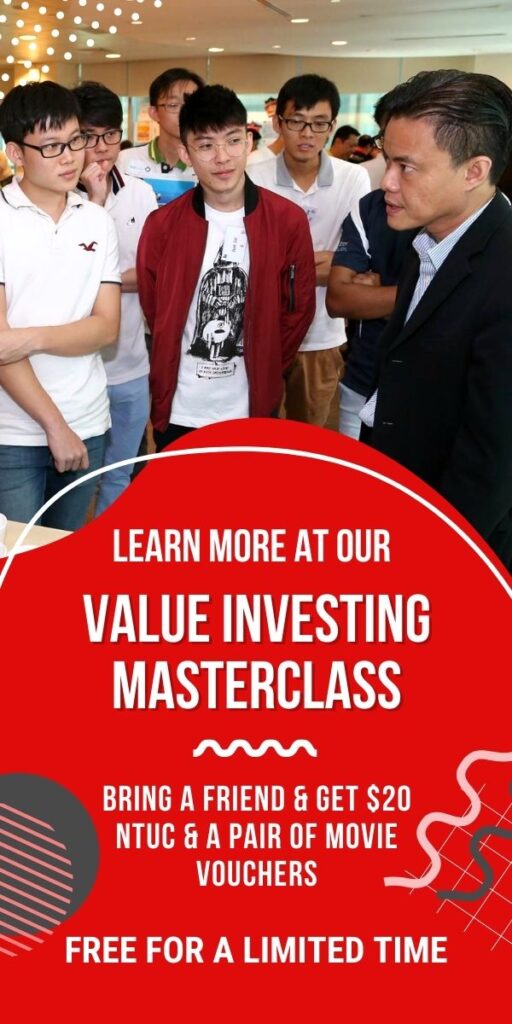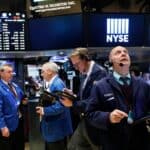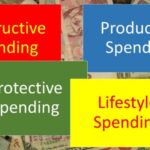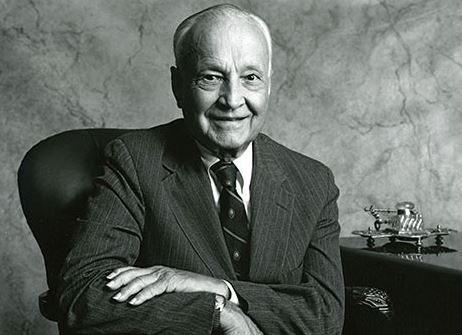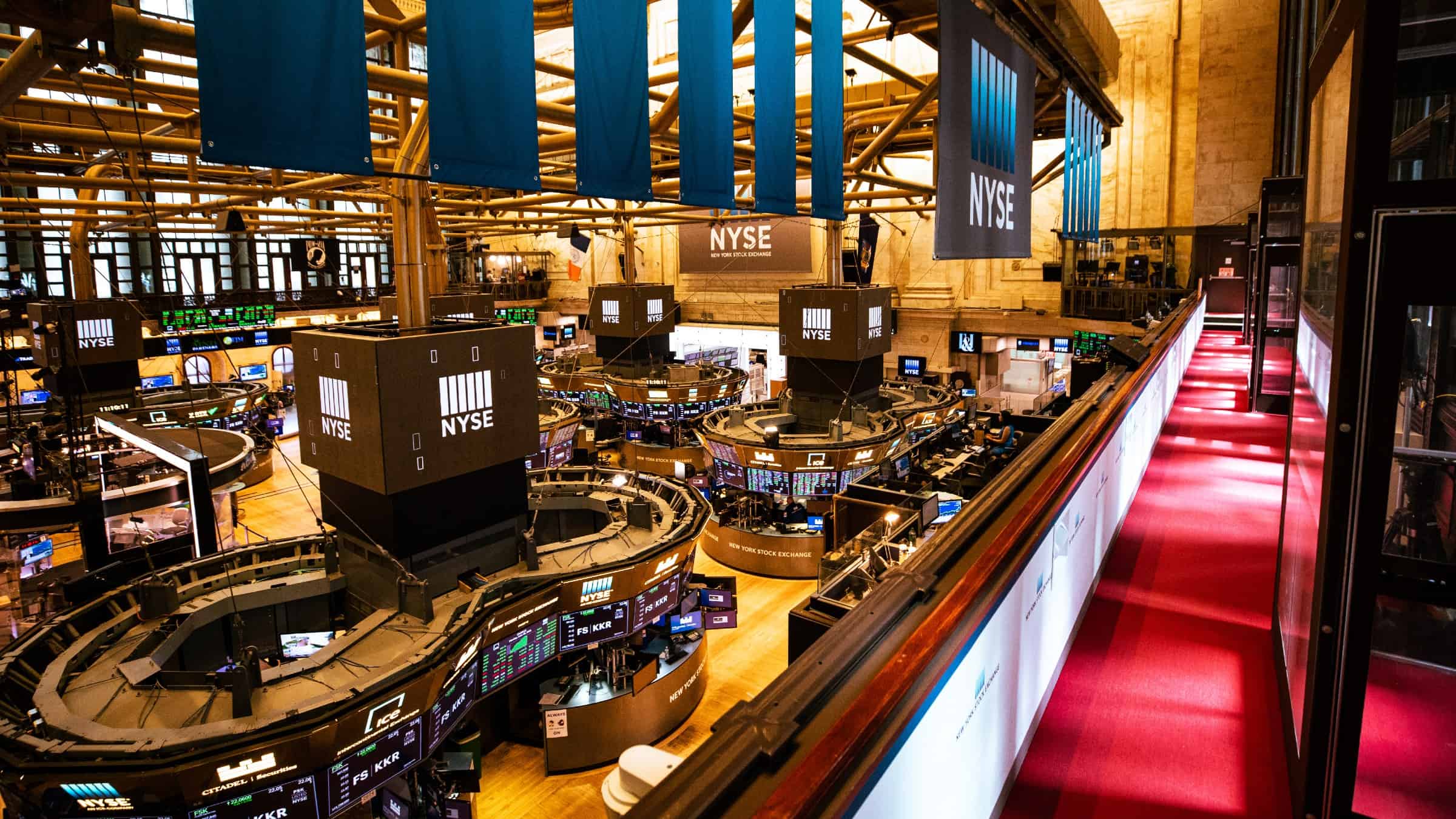Introduction
The goal of this blog article is to help demystify the world of investing and to provide information that will actually be useful to you so that, you can start investing immediately. In the beginning portion of this blog, we’ll address the most common myths surrounding stocks, the stock market and why they are just myths. Then, we’ll look at the most famous investor of all times and what makes him so good at picking great stocks using an investing method known as Value Investing.
Next, you’ll learn about the various types of investments you can actually buy and why you can invest in them. These are not theoretical examples of what might work for investors. Rather, they are actual investments you can choose from and learn more about before buying them. We will also go through why by reinvesting using the earnings, it can have such a huge positive impact on your finances, and how the magic of compounding really does work in your favor. Following that, we’ll cover the best strategies to use when deciding how often you should purchase investments.
For those of you who want to get right to the point and start investing right away, the remaining sections will take you step-by-step through each process. From registering your online broker account, to making your very first stock purchase, and how to access your earnings whenever you want them. Again, this blog article is really meant to help to you, regardless of whether you have zero experience in investing, some experience in investing and even bad experience in investing.
“The first step is you have to say that you can” – Will Smith.
(A) Story of John Part 1
Today, I am very excited because I will be meeting up with my friend John for a cup of coffee. I’ve not seen him for over a year due to our tight schedules. John is a great guy who works very hard and spends whatever little free time he has with his family. Honestly, I’m not sure how he does it though. Anytime we’d speak on the phone he sounded exhausted and said he was always struggling to keep up with everything.
After our last conversation I suggested we meet up so we could discuss what’s been happening and maybe some ways I could help him out. This interested John so he agreed to meet with me at my office to talk about it in more detail. You see, for the past several years I’ve been pretty successful with my investments and businesses, and I’m always willing to help out others to do the same. Having our coffee, we sat down and started discussing about his situation.
So John, tell me, how’s everything going? Financially, I mean. John replied, not so good, it’s tough you know. I’m working 40-60 hours a week depending on what my boss wants me to do at the office, and I’m struggling to keep up on all my payments. Between the mortgage, monthly bills, credit card debt, and my kids always needing money for school, it’s really tough. My wife, Natalie and I are doing the best we can but it’s not enough. We’re always worried about having money for the future, be it for us or our kids.
That’s why I wanted to meet up with you. I heard that your company does something with investing and know that you’re doing really well. So, I thought I’d come and see how you do it and learn more. I looked him right in the eye and said, well, I’m really glad you’re here John because you and I are going to fix your situation right now.

(B) 5 Myths of Investing in Stocks
I asked John what he knew about investing and about generating passive income. His reply was one I’ve come to hear quite often. He said, what little he knew about investing came from movies like The Wolf of Wall Street (2013), Wall Street 2: Money Never Sleeps (2010), Too Big To Fail (2011), or came from listening to advices from brokers, newspapers, radio, etc. He thought investing was something only rich people do because they already have money and for them to lose it away is no big deal.
Sadly, this is what many people believe as well, that investing in the stock market is something only rich people do and that it’s just like gambling in a casino. It’s just a game of luck and you can lose all of your money so quickly, so why bother investing at all. This is simply not true. If an individual investor thinks this way, it’s a sure bet that they will eventually gamble away all their money.
It reminded me of a famous quote by Paul Samuelson who said, “Investing should be more like watching paint dry or watching grass grow. If you want excitement, take $800 and go to Las Vegas.” John and I had a good laugh for a moment and I then said, that if you think investing is just like gambling, you’re doing it completely wrong. It takes planning, patience, careful research, and time.
If an individual investor is willing to spend a little time learning about the stock market, how it works, and what to do to minimize their risk, well then, they will do very well financially. John then said, that’s great to hear but to be honest, I’m still confused from what I’ve heard about investing and from what your telling me now. Hearing this, I decided to explain to him the five myths of investing and why they are really just myths. After all, once you get past the myths you can then look at what is real and make some very good decisions.
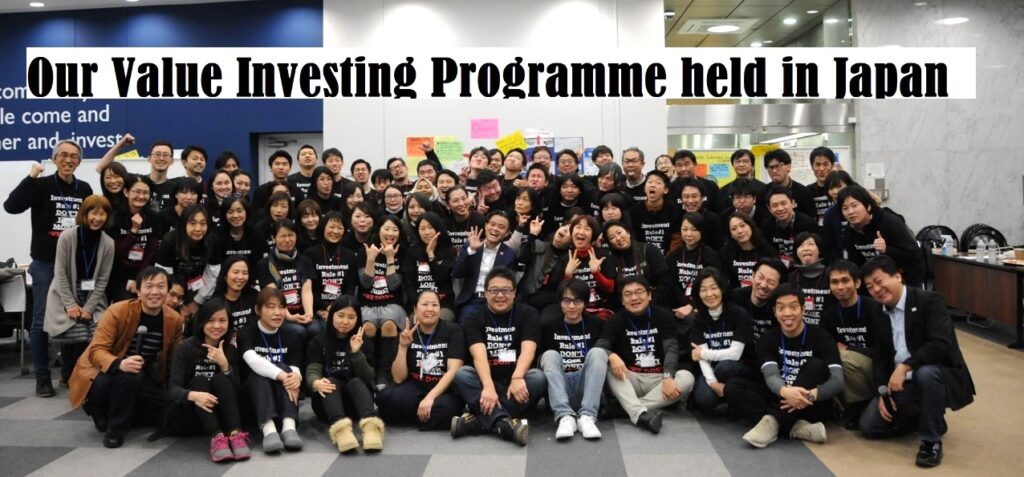
With investment fiascoes like Enron, Lehman Brothers, the Libor or London Whales scandals, and financial analysts’ giving conflicting or bad advice, an investor’s confidence can be low in the stock market. Many investors wonder whether or not investing in stocks is really worth all the hassle and confusion. Sure, bad things had happened in the past and possibly will happen in the future but those are because of people who chose to commit bad or harmful actions against others.
This does not always happen as there are many investors who choose to do good, and help others improve their financial situations in an honest way. It’s important to always keep a realistic view of the stock market, but to also keep in mind the more you know the better off you will be when it comes to making decisions regarding your investments. Regardless of the reasons, be it real problems or not, common myths about the stock market often arise. These are the top five myths most people believe today

MYTH #1 INVESTING IN STOCKS IS JUST LIKE GAMBLING (I.E. GUESSING STOCK PRICES)
This reason alone causes many people to shy away from investing in the stock market. Often times, people will confuse the two words of investing and gambling/trading/speculating to mean the same thing. To make an investment means, to use money to purchase something offering profitable returns, especially interest, dividends, or income. Gambling means, to play a game of chance for wagering stakes, by using money or anything of value, to bet on its outcome. Which gamblers that you know has make money consistently? But I do know which casino has make money consistently from the gamblers. So who do you want to be? The one that gambles, or the one that owns/invest in the casino.
To understand why investing in stocks is inherently different from gambling, it’s important to know what it means to buy stocks especially one that has great value. To buy a share of a common stock is to take some ownership in a company. It entitles the owner of the stock to a share of the assets as well as a fraction of the profits that the company generates. Investors often, mistakenly think of shares as simply a trading vehicle, and they forget that the stock represents their ownership in a company.
By purchasing a share of a company’s stock you not only own a share of the company, but if the company is profitable they can issue dividends which are directly paid to it’s share holders. Alternatively, if the price of the stock goes up, you can sell it for a profit. Many view the stock market as something unpredictable which fluctuates up and down like a yo-yo, but in general its trend is always moving up. For example, if you buy Starbucks shares, you are a shareholder of Starbucks. Because you are a shareholder, you are entitled to its dividends. But our role is not to guess the stock price of Starbucks.
Since, the outlook for business conditions is always changing, so too are the future earnings of a company. Stock prices fluctuate because a company’s earnings also fluctuate year to year. All of this is okay since investing is done with the goal of it being for the long-term. Investors know that good companies will continue to do well and generate returns for their shareholders even if they occasionally have a bad year. This yo-yo effect becomes less of a concern as a company’s long-term growth continues to move in a forward and positive direction.
In the short-term, a company can survive without profits because of the expectations of future earnings, but no company can fool investors forever. Eventually, a company’s stock price can be expected to show their true value to its shareholders. If they are positive and consistent, then a company’s stock price will reflect this data and investors will profit from their investment. There are many ways of investing in stocks but the one that has been working close to a century is known as value investing.
Gambling, on the other hand, is a zero-sum game. What I mean to say, is that the goal of placing a bet or wager is to merely win money by taking it from a loser and giving it to a winner. No value is ever created. When a person chooses to gamble they have to place short-term bets hoping to win a lot of money quickly. And here-in lies the problem.
At best, a person who gambles may earn some money immediately but no matter how much they win, they will not be able to continually generate income in the future from the same bets. They will need to constantly place new bets hoping that they pay off. However, people forget that when gambling, the true winner is the house (i.e. The casino) because they control the stakes and payouts. As any experienced gambler will tell you, no matter who you are, the longer you keep betting, the house will always win.
By investing your money in the stock market, you help to increase the overall wealth of an economy creating more jobs for others. This allows companies to become more innovative and competitive increasing their production of better products and goods. All of which translates into an increase in their value and profits which benefit their shareholders. This is how investing is different from gambling. Investing creates long-term wealth generation, where as, gambling creates short-term gains if you win, and after the house takes its share first. Don’t confuse investing and creating wealth with gambling’s zero-sum game.
MYTH #2 THE STOCK MARKET IS AN EXCLUSIVE CLUB FOR BROKERS AND RICH PEOPLE
This is absolutely untrue. Any person, regardless of their financial background can invest in the stock market. What many people forget, is that, everyone had to start investing in order to become rich, even if it was only with one dollar. The purpose of the stock market is to be a place where anyone can buy or sell stocks. Not a place only rich brokers and investors work like those depicted in movies or television.
As Robert Kiyosaki says, “My rich dad also thought that the Hollywood version of investing was financial silliness. ‘Many people think investing is this exciting process where there is a lot of drama,’ he said. ‘Many people think it involves a lot of risk, luck, timing, and hot tips. But to me investing is a plan—an often dull, boring, and almost mechanical process of getting rich.’ For rich dad, the dull, boring, and almost mechanical process of getting rich was his formula based on his favorite game, Monopoly, a game he taught his son and me when we were kids.
That formula was simple: Buy four green houses. Exchange four green houses for a red hotel. At the time he was teaching us this formula, rich dad didn’t have his red hotel in real life. But by following his plan, he had a number of them within ten years.
Rich dad was adamant that this was not a difficult or complex process. He simply invested in a good deal and then “traded up” those investments when able. ‘One day,’ he said, ‘I woke up and realized I was rich.’
The question is, if investing is a matter of simply following a formula, then how come most people don’t follow the same formula? The reality is that most people do not want to follow boring formulas. They get dull. Most people start following a plan and then they get bored. The result of this is often a loss of money or breaking even. With the exciting and wild swings come fluctuations in money but never the slow, steady, measured growth a true investor looks for. ‘Most people think there is some magic to getting rich through investing,’ rich dad said. ‘Or they think that if it is not complicated, it cannot be a good plan. Trust me. When it comes to investing, simple is better than complex.’”
Just because many brokers or market advisors claim to be able to know the markets’ every turn, the fact is that, almost every study done on this topic has proven these claims are false. Most brokers are notoriously inaccurate and can be misleading. Years before, they were the only ones to have all of this information at their finger tips. Its meanings were clouded in mystery and difficult to interpret even if a non-professional brokers could get their hands on the same information. However, within the last few decades the internet has made the market much more open to the public than ever before. All the data and research tools previously available only to the brokerage firms are now there and easy to access for individuals to use as well.
MYTH #3 FALLEN ANGELS WILL GO BACK UP, EVENTUALLY
What do I mean by this? Well, often times amateur investors will think that a stock trading near its 52-week low is a good buy. Whatever the reason for this myth’s appeal, nothing is more destructive then to think this way. There is a Wall Street proverb that says, “Those who try to catch a falling knife only get hurt.” Meaning, when a stock is falling in price, don’t try to guess where it will bottom out. This can lead to costly mistakes causing you to loose money.
For example, suppose you are looking at two stocks:
- Starbucks (SBUX) had an all-time high last year with it’s stock price ending around $50, but has since fallen to $10 per share.
- Wells Fargo (WFC) has recently gone from $5 to $10 per share.
Which stock would you buy? Believe it or not, all things being equal, a majority of investors will choose SBUX, because they believe that it will eventually make it back up to $50 or similar levels again.
Thinking this way is the worst idea in investing! Price is only one part of the investing equation but value is the other larger part. The goal for any investor is to buy good companies at reasonable prices using a method known as value investing. Buying companies solely because their market price has fallen or has gone up will either get you nowhere or in a negative cash situation. This reminds me of a famous quote by Warren Buffett, who said, “Price is what you Pay, Value is what you Get.” We’ll talk more about him later but the point is, to always buy a good company at a reasonable price.
MYTH #4 STOCKS THAT GO UP MUST COME DOWN
The laws of physics do not apply to the stock market and if an investor believes this, they can make serious errors in their investing strategies. Unlike the physical world we live in, there’s no gravitational force to pull stocks back to an even or ground level. The stock market is always moving forward and upward even during those years when there are corrections or losses.
For example, in 1980, Warren Buffett’s company Berkshire Hathaway’s (BRK-A) stock price was at $167 per share which was a bit steep but fair since it’s considered a good company. Then, between 1990 and 1994, the price went from $7,455 to $17,250 per share. In 1998, it climbed to $78,305, in 2004 to $94,500, and in 2007 it moved to $141,600 per share. Had you thought that this stock was going to return to its lower initial position, you would have missed out on the subsequent rise to its current price of $215,824 per share over the years.
Of course it’s great to see a company’s highs but what about when there are market corrections in which the stock drops in price? Sure, this happens at various times during a company’s life span but a good company always recovers and gains in price just like the stock market overall in the long run. Berkshire Hathaway is no different. In 2000, and 2008, it’s price decreased by several thousand dollars but it always returned stronger and higher then before. The point, is that the stock price is a reflection of the company. If you find that it’s run by excellent managers, then there is no reason the stock won’t keep on going up. This graph shows the company’s performance over the past 45 years.
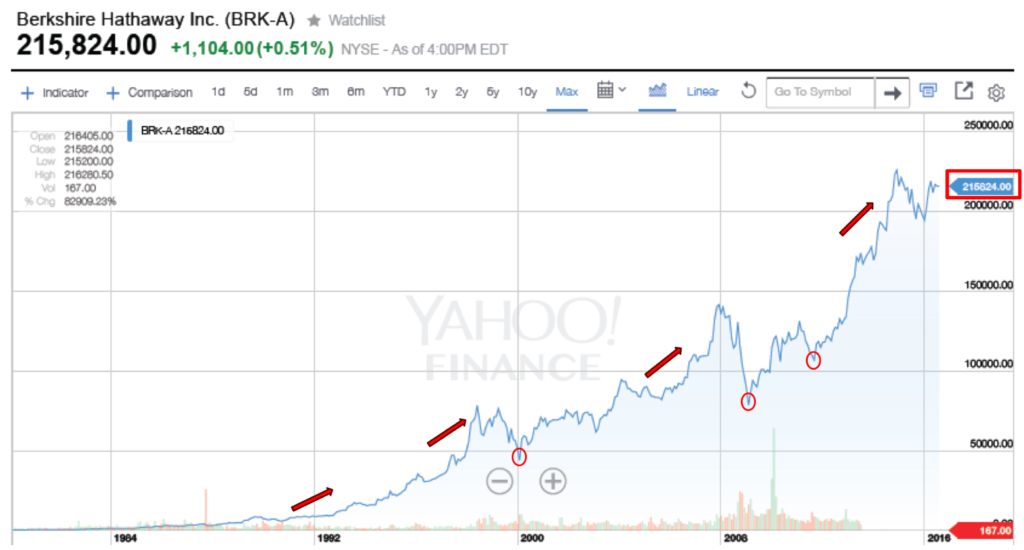
MYTH #5 A LITTLE KNOWLEDGE IS BETTER THAN NONE
Normally, this can be true in people’s daily lives as a little knowledge may be all you need in order to do something. However, it is not true when it comes to investing. It’s crucial in the stock market that an investor have a clear understanding of what they are doing with their money. Those investors who do their homework and put in the work are the ones that succeed.
Not everyone has the time or energy to research and learn how the market works, so they will seek a good financial advisor to help them decide what to do with their money. This may come from a company, a seminar, even a book, but the important thing is that they are learning why they’re investing their money and how it works. The cost of investing in something that they do not fully understand far outweighs the cost of speaking with an investment advisor.
Just like the old Wall Street saying goes, “What’s obvious is obviously wrong.” This means that knowing a little bit will only have you following the crowd making choices you don’t understand which could lead to costly mistakes. Successful investing takes a little hard work and effort but is definitely manageable for even those with busy and hectic lives. Another way to think of it, is imagine that a partially informed investor is like a partially informed surgeon. The mistakes they could make, could be severe, and cause injuries to their financial health.
John’s response to all of this was very positive as he said he never knew any of this information. He simply thought, that what everyone else had said about investing was true. This is not uncommon for many people, as we tend to form opinions from what information we can gather, even if it is clouded or inaccurate. I explained to John that it’s always important to form his own opinion and learn the best ways to invest his money in order to make it grow. The truth is, by investing in yourself and your own knowledge you will gain more then you ever thought possible.

Now, having dealt with John’s misbeliefs in the stock market I decided it was time we look at someone who is really successful at investing. What better example then to look at the man who is known as an investment guru and often times referred to as, ‘The Oracle of Omaha,’ Warren Buffett.
“If you really want to do something, you’ll find a way. If you don’t, you’ll find an excuse” – Jim Rohn.
3) WARREN BUFFETT – THE MAN WHO MADE VALUE INVESTING POPULAR
When I first asked John if he’d ever heard of Warren Buffett he looked at me a little puzzled at first and then said, sure, he’s the guy who owns the popular all-you-can-eat restaurant buffet’s right? Hahahahaha! I laughed out loud. If only that were true, then he might not only hold the title for being the most successful investor in the world but he might also be the heaviest too. Both John and I got a good laugh out of his remark and then he said, isn’t he the really rich guy known for investing? That’s right John, but there is a little more to him then just that, I replied. After my laughing died down a little I was able to talk more about who Warren Buffett is.
CHILDHOOD AND INVESTING
Born on August 30, 1930, in Omaha, Nebraska, Warren Buffett’s father, Howard Buffett, worked as a stockbroker and as a U.S. congressman. His mother, Leila Stahl Buffett, was a homemaker, and he was the second of three children with one older and one younger sister. Demonstrating a knack for financial and business matters early in his childhood, friends and acquaintances said that young Warren was a mathematical prodigy who could add large columns of numbers in his head. This talent is one he occasionally demonstrated later in his life as well.
As a child Warren often visited his father’s stock-brokerage shop, and wrote the stock prices on a chalk board in the office. At 11 years old he made his first investment, buying three shares for his sister Doris and three shares for himself, of Cities Service Preferred at $38 per share. The stock price quickly dropped to $27, but instead of panicking he and his sister held on to their shares until they reached $40. They sold their shares for a small profit, but regretted the decision when Cities Service shot up to nearly $200 a share not long after. Warren later said that this experience served him as an early lesson to having patience in investing.
FIRST ENTREPRENEURIAL VENTURE
By the age of 13, he was running his own businesses as a paperboy while selling Coca-Cola beverages, golf balls, magazines, and his own horse-racing tip sheet. He also filed his first tax return, claiming his bicycle as a $35 tax deduction to reduce his taxes.
Then in 1942, while in high school, Warren and a friend of his purchased a used pinball machine for $25. They installed it in a barbershop with the hopes of making money continually from other children playing it. Within a few months the profits they earned enabled them to buy even more machines. Warren owned pinball machines in three different locations before he sold the business for $1,200. By the age of 15, he amassed $2,000, bought a 40-acres farm and hired staff to run it. All the while using the nearly $10,000 in profits he earned to attend university.
HIGHER EDUCATION AND EARLY CAREER
After completing his Bachelor’s degree, he applied to Harvard Business School only to be rejected. This did not stop him from pursuing his dream of becoming a full-time investor though. Being influenced by Benjamin Graham’s book, The Intelligent Investor (1949), Warren enrolled at Columbia Business School to study under Graham who is considered an acclaimed economist and investor.
Earning his master’s degree in 1951, he started selling securities for his father’s firm Buffett-Falk & Company. After a few years, he then went to work for his mentor Benjamin Graham as an analyst at the Graham-Newman Corp. (GNC) There he worked closely with Walter Schloss and Graham, who was said to be a tough boss. Mr. Graham is considered the father of Value Investing which is what he and his business partner, Walter Schloss both practiced at their company. People familiar with the term value Investing in modern times might associate it with Warren Buffett and the analysis of a business’s ability to generate above-average and sustainable profit margins and cash flows to determine intrinsic value with a focus on the Income and cash flow statement. Buffett wants to find companies – companies that can grow intrinsic value over time. Buffett will always be the poster child for value investing.
The principles of Value Investing are to find good companies at a cheap price. This methodology proved to be very successful for any investor and Warren quickly learned how to apply these principles in finding good companies at a good price. In 1956, Benjamin Graham retired, closing his partnership allowing Warren to take his personal savings, which was over $174,000, and started Buffett Associates Ltd.
As he became more successful, he created and managed a total of 7 partnerships in just a couple of years. During which time, he met Charlie Munger, another very successful investor and future business partner. By 1962, Warren decided to take all his partnerships and place them under one company, called Buffett Partnerships Ltd. Forming this partnership in his hometown of Omaha, Nebraska he utilized the techniques learned from Benjamin Graham called Value Investing.
Warren was very successful in identifying undervalued companies using value investing, investing in them, and quickly becoming a millionaire. Buffett Partnerships Ltd., had a combined total value of $7.17 Million and Warren himself was worth over $1 Million. By 1965, he decided to invest in an undervalued textile company named Berkshire Hathaway.
At this point, I could see John’s eyes begin to close slightly giving me that look of partial boredom so jokingly, I told him that this is the year Warren Buffett became the first investor to go to the moon. Investing in a rocket ship, he and several of his business partners took a short trip to the moon and back for a mere $10,000 each. Shaking his head, John’s eyes flew open and he said, wait. He went to the moon? I never knew that. How could an investor go to the moon? He didn’t, I replied. I was just checking to see if you were still following me. I know this can seem a little dull but it’s really important to know this information since I’m not just describing Warren Buffett’s success story. What I’m really outlining is how he became wealthy through investing. The more you understand this concept, the better off you will be in your own investing success.
BUSINESS EMPIRE
Despite the financial success of the Buffett Partnership Ltd., Warren decided to close it in 1969. Having gained ownership of Berkshire Hathaway, he and Charlie Munger began buying assets in media (The Washington Post), insurance (GEICO) and oil (Exxon). Making Berkshire Hathaway (BRK.A) into a publicly traded company Warren became immensely successful, even managing to fix and profit from bad investments. Thus earning him the title, the ‘Oracle of Omaha.’k
In 1970, he began writing his now-famous annual letters to his shareholders which show everything the company has invested in and clearly outlines its future direction. These letters are sought after by many people who wish to learn what companies Berkshire Hathaway is investing in and how successful they are becoming as a result. For example, in 1979, Berkshire began the year trading at $775 per share, and ended at $1,310. At the time, Warren Buffett’s net worth reached $620 Million.
Over the course of the next forty-years, Berkshire Hathaway acquired stock in popular companies such as; American Express Co. (AXP), Costco Wholesale Corp. (COST), DirectTV (DTV), General Electric Co. (GE), General Motors Co. (GM), Coca-Cola Co. (KO), International Business Machines Corp. (IBM), Wal-Mart Stores Inc. (WMT), Proctor & Gamble Co. (PG), and Wells Fargo & Co. (WFC). Not only is Warren Buffett continuing to grow Berkshire’s earnings each year, he also is able to successfully weather the financial storms hitting the stock market.
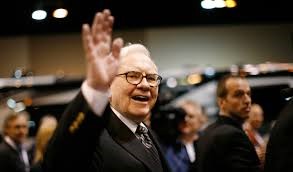
Notably, the stock market crash in 1987 also known as Black Monday is considered the single worst financial loss in history. Many investors and companies lost a great deal of their investments including Berkshire Hathaway. Its share price dropped from $4,200 to $3,100 per share. But due to Warren’s strong investment style in value investing and his buying 7% of The Coca-Cola Company stock, Berkshire’s price rose to $8,000 per share by 1989.
Before the Dot-Com market crash in 2000, Berkshire’s price was around $57,000 per share and though it dropped a little due to the crash, by the end of 2001 it was trading for a little above $75,000 per share. Even with the Mortgage Crisis of 2008, Berkshire Hathaway’s share price remind high. Trading above $100,000 a share, less then a year after the Crisis it continued to climb even higher.
AS A BILLIONAIRE
In August 2014, the price of Berkshire Hathaway’s stock hit $200,000 a share for the first time and Warren Buffett’s net worth reached $64.2 Billion. As a long time philanthropist with a strong desire to give back to the world community Warren announced in 2006, that he will gradually give away 85% of his Berkshire holdings to five foundations in annual gifts of stock. With the largest contribution going to the Bill and Melinda Gates Foundation. His donation has become the largest act of charitable giving in United States history. In 2010, Warren Buffett and Bill Gates announced they had formed The Giving Pledge campaign to recruit more wealthy individuals for philanthropic causes.
Even with his net worth in the billions and his enormous charitable donations Warren has not stopped investing. Buying shares in companies such as; Precision Castparts (PCP), Phillips 66 (PSX), Kraft Heinz (KHC), Burger King/Tim Hortons (QSR), and taking ownership of Dairy Queen and Fruit of the Loom (BRK.B) in 2015. At 85 years of age he is not showing any signs of slowing down. He is continually building his wealth through investments and adding to his charitable donations, because as he once stated, “If you’re in the luckiest 1% of humanity, you owe it to the rest of humanity to think about the other 99%.”
WARREN BUFFETT’S WEALTH
As of June 2016, his net worth reached $66.5 Billion making him the third wealthiest man in the world, and the second wealthiest man in the United States. So how did he do it? Warren is famous for his folksy yet incredibly wonderful investment advice, but perhaps none of that advice sums up his investment philosophy better than this gem of wisdom offered up to his investors in 2013. “It’s better to have a partial interest in the diamond than to own all of a rhinestone.” Meaning, it’s much better to own a smaller piece of a great company then it is to own all of an average performing company.
His passion for numbers is rivaled only by his passion for bargains, and over the past 60 years, ‘the Oracle of Omaha’ has built a portfolio of top-tier companies that have made him one of the world’s richest men. Being an active equity investor that’s willing to take stakes in great companies even if he can’t buy them outright has served him extremely well. For example, during the last U.S. recession, he orchestrated money making deals with Goldman Sachs and Bank of America that reinforce his belief that it’s better to own a little of something that is valuable, than all of something that is not.
Well known for his frugality, Warren still lives in his Omaha home which he purchased for $31,500 back in 1958. He is always thankful to those who have supported and helped him along the way, and says that his best investment was buying Benjamin Graham’s book, The Intelligent Investor (1949), in 1949.

The Word ‘Value Investing’ is probably most closely associated with Warren Buffett than just any other investor in the world and that’s rightly so. After all, Buffett’s the fourth richest man in the world with a fortune worth about US$82.7B *(as of Apr 2019) that was built almost solely on investing in business and the stock market. Value Investing has indeed evolved a lot from Graham’s thinking to Buffett’s Current philosophy.
FUND MANGERS VS. SELF INVESTING
Looking a little surprised, John said, wow, I had no idea that he was such a successful investor from such an early age. Although, it seems like he had a bit of an advantage since his father was involved in the stock market, so, what about someone who has no experience in the market? I fear that I’d lose all my money picking the wrong stocks or that I wouldn’t have enough money to buy the really good stocks. Sure, that is of course everyone’s concern but the difference between Warren Buffett and other investors is that he researches what he will invest in first and determines if it is a good company before investing in them.
Right, that makes sense, but that sounds very time consuming and like a lot of work. I heard some people talk about using a fund manager. Someone who is a professional investor. Couldn’t I just use them and save myself the trouble of doing all the work? Plus, shouldn’t they know the best stocks to invest in since they are professionals who do this for a living? I mean, wouldn’t my chances be better giving my money to an expert to invest for me so they can make sure I make a lot of money from my investments? John replied.
Well my friend, you’re both right and wrong. It’s true that fund managers are professionals who spend their days’ investing other people’s money with the goal of making more for their clients. However, a fund manager is not responsible for what happens to their client’s money. If the investments, they make for their clients don’t do well or underperform the fund manager holds no responsibility. The fund manager gets paid everyday even when their clients are loosing money. What? But, I thought they only make money if their clients make money, said John.
Ahh, that is the misperception most people have. You see, fund managing firms are set up to invest money for their clients while collecting fees from them. They collect a premium on everything they do for you, sometimes even calling them will be charged to your account. Fees for these managers often run between 0.6% to 2% which can add up. It’s not to say that they won’t do their best to make you more money but their investment strategy is their own and may be very risky or a huge gamble. They will claim that they can make a lot of money quickly but what they don’t say is that it comes with a very real and very high risk.
Think of it this way. When you go to place a bet on a game of any kind, you usually have to give the money to a bookie to hold onto until the end of the game. So, if you win, you go back and collect your winnings, but if you lose, you don’t get anything back and the person who won gets your money. Now, regardless of what happens in the game the bookie makes money from you. That’s because they collect a fee from you anytime you make a bet and either way, win or lose, they make money. Fund managing firms operate in a similar fashion. I know this is a crude example but by giving your money to a fund manager you are essentially making a bet and win or lose they will make money from you.
To be honest with you John, the best advice I have for you or any investor for that matter is to learn from Warren Buffett’s example on how to be a good investor. Start by investing in yourself and learn about how the market works, then research companies you might be interested in investing in. Get advice from financial advisors if needed, but still do your own homework and learn about the investments before you put your money into them. It takes a little time and energy at first but it’s worth it in the long run.

Now, I understand that you like many other people don’t have a lot of time to spend researching how to invest in the stock market, but I would say to at least spend 10 minutes a day learning about the market. This way, you are always learning something about investing and you are moving forward toward your goal with investing. The only word of caution I would have is to be weary of fund managers and stock brokers. This is because they’re not always clear about their fee structures, and they usually are paid regardless of how you do in the stock market.
“There are a few investment managers, of course, who are very good – though in the short run, it’s difficult to determine whether a great record is due to luck or talent. Most advisors, however, are far better at generating high fees then they are at generating high returns. In truth, their core competence is salesmanship. Rather than listen to their siren songs, investors – large and small – should instead read Jack Bogle’s The Little Book of Common Sense Investing” – Warren Buffett.
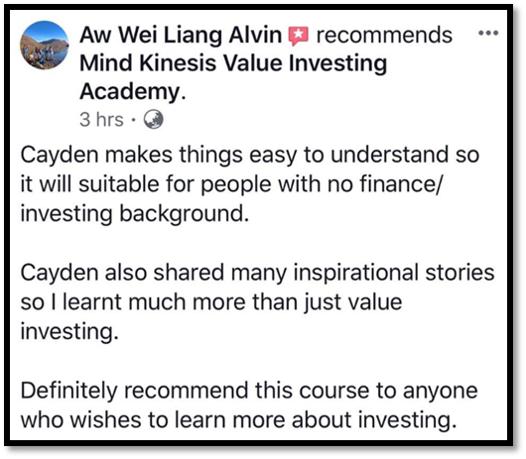
WHAT’S BETTER? FUND MANAGERS OR INDEX FUNDS?
There has been a debate concerning the profitability fund managers provide compared to the stock market index funds. Between them, there is a bright distinct line dividing these two fundamentally different approaches to investing. Numerous studies have shown that index funds, with their low costs and ability to closely mimic the returns of markets both broad and narrow, steadily outperform the returns of most actively managed funds.
To better understand why there is a difference between the two, we need to look at the distinction between funds that are managed and those that are indexed. Actively managed funds are handled by an individual or team of managers. Successful management of a fund requires evaluations of a fund’s investing style, growth, risk and return profile, trading activity, costs, and performance. How well they score in these areas is important and can determine if an investor utilizes their services or not.
Index funds are passively managed, which means that their portfolios mirror the components of a market index. Because of this, the costs associated with an index fund are much lower then an actively managed fund. For example, the highly well-known Vanguard 500 Index fund is composed of the same 500 stocks as it’s counter part the Standard & Poor’s 500 Index. It is also based on the same market capitalization scheme and costs much less then an actively managed fund. So, let’s look at why index funds are performing so much better then those funds which are actively managed by fund managers.
ACTIVELY MANAGED FUNDS
Really, the big difference comes down to where do you think your money will give you the biggest return? This is usually the argument most people will make when siding with fund managers to invest your money. The idea being, that a well-run actively managed fund with a long-term performance record which is above their peer and category benchmarks are excellent investing opportunities. There are even a number of top-rated fund managers that consistently deliver exceptional yearly results.
These are all fantastic things to hear and generally would be enough to convince someone with little or no investing experience to decide on using a fund manager. I mean, why wouldn’t you? If a fund manager can continually give their clients high yearly returns, then why not invest with them? Well, something they may not mention, is that despite their impressive long-term records, even top-rated fund managers can have bad years. Also, in recent years, a number of fund management-related issues have received more public attention in the financial press than in the past. These fall under the general heading of fund stewardship and include such issues as a manager’s financial stake in a fund, performance fees and the composition of a fund’s board of directors. Article Title: Fund Management Issues, Author: Richard Loth.
When chosen properly, actively managed funds can bring significant benefits and advantages to an investors portfolio. Year after year however, the performance of most actively managed funds does fall short of whatever index is most appropriate for the funds’ benchmarks. Some will use the S&P 500 as a benchmark or various other indexes to compare against the performance of fund managers. In 2015, both The Washington Post & CNN Money, reported findings to support why indexes outperform fund managers with data collected by Morningstar. Article Title: Active vs. Passive: How fund managers stack up to index funds, Author: Jonnelle Marte.
Morningstar is considered to be a highly respected and reliable investment research firm that compiles and analyzes funds, stocks, general market data, and provides a source of independent investment analysis for all levels of investors. They conducted a comprehensive study and found that in 2014, nearly 86% of all fund managers under-performed compared to the S&P 500. Not to mention that, almost 89% of fund managers under-performed over the past five years, and 82% under-performed over the past ten years. But the real question is why? Are they just bad managers or are they taking huge risks and not doing their homework before investing their clients’ money? Article Title: 86% of investment managers stunk in 2014, Author: Matt Egan.
Well, it’s possible some fund managers fall into these groups but most certainly not all of them. The main reasons they consistently under-perform compared to the S&P 500 Index is because of two reasons. First, taxes are a major factor to take into account. High-turnover active funds can leave investors at a disadvantage, as more taxes are likely to be owed than with a low-turnover fund. Second, actively managed funds under-perform because of their high expenses. While you might reasonably expect higher returns from a lower cost actively managed fund than from a higher-cost actively managed fund, both are still likely to under-perform compared to index funds.
Thus, this is where the problem with actively managed funds exists. Yes, a fund manager can generate a lot of money with their investments because of their knowledge and background. Although, the fees you will pay so they can provide this service to you will be substantially high. To show you how this works we’ll look at a simplified example which only looks at the costs for using a fund manager. For example, let’s say you had $10,000 to invest in the stock market and decided to use a fund manager to actively manage your investments.
They will earn you an estimated 6% yearly portfolio return on your investments and their fee to do this for you will range between 0.89% – 1.2%. I know this doesn’t sound like much, but keep in mind that the reason for the difference is due to how much money you give to them to manage. The less you give them the higher their fees, so, for our example we will use 1.1%, as your $10,000 is considered to be a rather small amount.
In addition, to that fee you will also need to pay another 1.0% to a financial advisor who works with the fund manager in assisting you with your investments. So far, that means, you are paying 2.1% from your annual returns on your $10,000 investment. Which doesn’t sound so bad, at least until you calculate what it actually means. To know what this adds up to per year we will use the same formula they use. It’s calculated by taking the management fees (2.1%), divided by the yearly portfolio returns (6%), to get the total amount you pay in fees from your yearly returns, which actually totals 35%! Article Title: The Heavy Toll Of Investment Fees, Author: Rick Ferri.
2.1/6 = 0.35 or 35%! Now, take that annual fee of 35%, which again, is the total you’re paying from the annual returns gained on your investment, and multiply it by your yearly returns. Not including compounding interest or any other additional fees added due to transactions, here is what your return would look like. First, let’s calculate your returns by taking, 6%(yearly returns) X $10,000(investment) = $600 (net yearly returns). Then, to get the total cost of management fees we can either take 35% X $600 = $210 (fees) or take 2.1% X $10,000 = $210 (fees). This means you actually only earn $390 (net yearly returns – fees = actual earnings) from your investment.
Imagine for a moment that in 10 years from now, your $10,000 has continued to earn you 6% annually and the management fees remain the same. You would receive $4,110 in returns but you would pay $2,510 in fees. If we look at 20 years from now, you would receive $10,687 in returns growing your investment to $20,687 but you would have to pay $6,189 in fees. Look, I’m not trying to scare you or say that all management companies are the same but this is a very real example of how their fee structures work. I just want you to be fully informed and prepared before you consider using their services. The chart below summarizes this information for you to see clearly how it works.

INDEX FUNDS (ETFS)
Since the fees attached to having a fund manager are so high, what then is the alternative? The simple answer is Indexes. Index funds are easily understood, and provide a relatively safe approach to investing in broad segments of the market. They are used by less experienced investors as well as lifetime institutional investors with lots of investments. An easy way to understand index funds is to think of them as investing on autopilot.
Index investing is simple, relatively cheap, and continually generates good returns. Index funds provide:
- Simplicity. An Index makes broad-based market asset allocation and diversification easy.
- Management quality. Indexes eliminate investor concerns over management issues and reliability.
- Low operational expenses. Indexing is less expensive due to a lack of management fees, fewer costs, and less taxes.
- Performance. Multiple studies show that index funds have outperformed the majority of managed funds over a variety of time periods.
For these reasons fund managers continue to struggle in their performance compared to Index funds. What I mean, is that, yes it’s true many fund managers’ will earn a great deal back from their investment strategies but due to their high costs, they continually under-perform compared to their benchmarks. Those benchmarks being the S&P 500 or Dow Jones Indexes which measure a fund’s returns against the returns of a benchmark appropriate for that particular investment category. Time and again, the under-performance of actively managed funds against these index benchmarks is significant. Article Title: Is There a Case for Actively Managed Funds? Low-fee index funds do a better job of meeting benchmarks, but some see specific uses for actively managed funds.
Let’s go ahead and take your $10,000 and see what your yearly costs would be if you invested in Index Funds. To start with, you don’t have a management fee so that is eliminated from the equation but you do have an operational fee. This fee can range from as low as 0.03% up to 0.12%. The great thing about this fee is that it only depends on the Index you invest in and not on how much you invest. For our example let’s just keep it simplified and say your yearly return is the same as before at 6%. We’ll select 0.12% in operational fees just to give you an idea of the high end cost for owning an Index Fund.
Our calculations will remain the same, so 0.12% (operational fees) / 6% (annual returns) = 2% (total operational fees). Next, take 6% X $10,000 = $600 (net yearly returns). Then, take 2% X $600 = $12 (fees) or take 0.12% X $10,000 = $12 (fees). This means you actually earn $588 (net yearly returns – fees = actual earnings) from your investment. The chart below summarizes how much you could earn over the next 20 years.

To put it simply, after 10 years you would have earned $6,723 or $2,613 more from investing in an Index Fund versus using a fund manager. In 20 years, you would have earned $19,612 or $8,925 more! For some people, this may seem like a small amount to get excited over but to me and those who don’t like loosing money, these gains are huge! All I’m saying is that, you can earn a high amount either way but the costs associated with using a fund manager are much higher then that of investing in an Index fund. If you’re still not convinced, I’d recommend learning about the costs associated with both and then form your own opinion. That, or you can follow the advice of the greatest investor of all time, Warren Buffett. Let’s see what he has to say. Want to learn more? Read up on the fees associated with actively managed funds:
- Investopedia: Pay Attention To Your Fund’s Expense Ratio
- Forbes: The Heavy Toll Of Investment Fees
- Bloomberg: An Investor’s Guide to Fees and Expenses 2014
- Betterment: Why Index Fund Portfolios Win
- AdvisoryHQ: Financial Advisor Fees in 2016

4) AN EASY AND SIMPLE WAY TO BECOME WEALTHY RECOMMENDED BY WARREN BUFFETT WHY WARREN PREFERS INDEX FUNDS (ETFS)
In Berkshire Hathaway’s 2013 Annual Report, Warren Buffett wrote, “When Charlie and I buy stocks – which we think of as small portions of businesses – our analysis is very similar to that which we use in buying entire businesses. We first have to decide whether we can sensibly estimate the earnings range for five years out, or more. If the answer is yes, we will buy the stock (or business) if it sells at a reasonable price in relation to the bottom boundary of our estimate.
If, however, we lack the ability to estimate future earnings – which is usually the case – we simply move on to other prospects. In the 54 years we have worked together, we have never foregone an attractive purchase because of the macro or political environment, or the views of other people. In fact, these subjects never come up when we make decisions.
It’s vital, however, that we recognize the perimeter of our “circle of competence” and stay well inside of it. Even then, we will make some mistakes, both with stocks and businesses. But they will not be the disasters that occur, for example, when a long-rising market induces purchases that are based on anticipated price behavior and a
desire to be where the action is. Most investors, of course, have not made the study of business prospects a priority in their lives. If wise, they will conclude that they do not know enough about specific businesses to predict their future earning power.
I have good news for these non-professionals: The typical investor doesn’t need this skill. In aggregate, American business has done wonderfully over time and will continue to do so. In the 20th Century, the Dow Jones Industrials index advanced from 66 to 11,497, paying a rising stream of dividends to boot. The 21st Century will witness further gains, almost certain to be substantial. The goal of the non-professional should not be to pick winners – neither he nor his “helpers” can do that – but should rather be to own a cross-section of businesses that in aggregate are bound to do well.
A low-cost S&P 500 index fund (ETFs) will achieve this goal. That’s the “what” of investing for the non-professional. The “when” is also important. The main danger is that the timid or beginning investor will enter the market at a time of extreme exuberance and then become disillusioned when paper losses occur. (Remember the late Barton Biggs’ observation: “A bull market is like sex. It feels best just before it ends.”) The antidote to that kind of mistiming is for an investor to accumulate shares over a long period and never to sell when the news is bad and stocks are well off their highs.
Following those rules, the “know-nothing” investor who both diversifies and keeps his costs minimal is virtually certain to get satisfactory results. Indeed, the unsophisticated investor who is realistic about his shortcomings is likely to obtain better long-term results than the knowledgeable professional who is blind to even a single weakness.
My advice, put 10% of the cash in short-term government bonds and 90% in a very low-cost S&P index fund. (I suggest Vanguard’s.) I believe the trust’s long-term results from this policy will be superior to those attained by most investors — whether pension funds, institutions or individuals — who employ high-fee managers.” Berkshire Hathaway Inc., 2013 Annual Report. Nebraska. Berkshire Hathaway Inc., 2013. pp. 21-22.
Basically, for an investor with little or no experience, investing in Index Funds (ETFs) and Bonds is the best way to go. By demystifying the world of investing, a new comer can easily get involved and not spend their days worried if their investment will provide good returns. This style of investing is truly what Warren Buffett believes is the best for anyone without the time to properly analyze stocks before investing. Additionally, Warren advises investors to always think of a few things before investing.
- You don’t need to be an expert in order to achieve satisfactory investment returns. But if you aren’t, you must recognize your limitations and follow a course certain to work reasonably well. Keep things simple and don’t swing for the fences. When promised quick profits, respond with a quick “no.”
- Focus on the future productivity of the asset you are considering. If you don’t feel comfortable making a rough estimate of the asset’s future earnings, just forget it and move on. No one has the ability to evaluate every investment possibility. But omniscience isn’t necessary; you only need to understand the actions you undertake.
- If you instead focus on the prospective price change of a contemplated purchase, you are speculating. There is nothing improper about that. I know, however, that I am unable to speculate successfully, and I am skeptical of those who claim sustained success at doing so. Half of all coin-flippers will win their first toss; none of those winners has an expectation of profit if he continues to play the game. And the fact that a given asset has appreciated in the recent past is never a reason to buy it.
- Forming macro opinions or listening to the macro or market predictions of others is a waste of time. Indeed, it is dangerous because it may blur your vision of the facts that are truly important. (When I hear TV commentators glibly opine on what the market will do next, I am reminded of Mickey Mantle’s scathing comment: “You don’t know how easy this game is until you get into that broadcasting booth.”)
Berkshire Hathaway Inc., 2013 Annual Report. Nebraska. Berkshire Hathaway Inc., 2013. pp. 20.
WHAT ARE INDEXES?
With a look of confusion John said to me, Well, that all sounds really good but I’m sorry, what is an index and what are index funds? That’s a great question! I’m so sorry John. Here I was getting excited and carried away about describing why investing in Indexes is a good thing and I forgot to explain what they are. The definition of what an index is goes like this: “An index is a statistical measure of the changes in a portfolio of stocks representing a portion of the overall market. It would be too difficult to track every single security trading in the country. To get around this, Indexes take a smaller sample of the market that is representative of the whole. Investors use indexes to track the performance of the stock market. Ideally, a change in the price of an index represents an exactly proportional change in the stocks included in the index.” Article Title: Index Investing: What Is An Index?
Basically, an Index is a way to track how the market is performing on any given day, and each Index is comprised of several companies’ stocks. There are several different types of Indexes which measure the stock markets performance in different areas depending on what you are interested in. An Index Fund is what you would buy if you wanted to own a portion of each of the companies which are included in that specific Index. They can be very expensive for new investors so there are alternative Indexes to invest in and they are called Exchange Traded Funds or ETFs. Let’s look at them and see why Warren feels they are a good investment.
MAJOR INDEXES
Although, there are many different types of Indexes covering all areas of the stock market the ones we’ll cover here are considered some of the largest in the United States. The first one, is the Standard & Poor’s 500 Index also known as the S&P 500 with ticker symbol SPX. It is an index of 500 of the largest corporations’ stocks which measures their value. These companies are chosen for their market size, liquidity and industry grouping, among other factors. The S&P 500 is designed to provide a quick look at the stock market and economy. Since, it’s a market value weighted index with each stock weighed in proportion to its market value only an overall decline or increase in the market will result in the index moving down or up. The S&P 500 is one of the most commonly used benchmarks for the overall U.S. stock market.
Next, we have the Dow Jones Industrial Average with ticker symbol DJIA. It is one of the oldest indexes and contains 30 of the largest, most influential companies in the United States. Even though the DJIA is a good index, most people agree that the S&P 500 is a better representation of the U.S. market. This is because the Dow Jones is price weighted and a decrease or incline in all stocks in the DJIA, would not necessarily cause a change in the index.
Third, is the Nasdaq Composite Index which is market capitalization weighted and comprised of all stocks traded on the Nasdaq stock exchange totaling around 3,000. It includes some companies which are not based in the U.S. as well. Movement in the Nasdaq generally indicates the performance of the technology industry, and speculative stocks both in the U.S. and worldwide. Fourth, is the Russell 2000, another market capitalization weighted index comprised of 2,000 stocks. It is the best-known indicator of the daily performance of small companies in the market. Finally, there is the Wilshire 5000 which is also a market capitalization weighted index comprised of 6,700 companies. It is sometimes referred to as, the total stock market index, or the total market index, because all publicly traded companies headquartered in the U.S. are apart of it. Article Title: An Introduction To Stock Market, By Kate Schick.
INVESTING IN INDEXES
How investing in an index fund works, is that, the money you place into the fund is automatically invested in proportion to the individual stocks or bonds according to the percentage they represent in the index. To put it simply, your money is divvied up and invested into a percentage of each company in that particular index. For example, if IBM represents 1.7% of the S&P 500 Index, then for every $100 you invest in the Index or in the Vanguard 500 ETF Fund, $1.70 goes into the IBM stock. Now, the stock might be trading at $158 a share, but due to it being apart of the Index and ETF Funds, you now own a small percentage of IBM. The returns and dividends you earn are based on the average returns and dividends from all companies in the Index.
TYPES OF INDEX FUNDS
Here is a quick reference guide on the different types of Index Funds. This is helpful when deciding what you most want to invest your money into. Just be aware that Mutual Funds and Hedge Funds cost more and can be riskier investments then Index Funds or ETFs.
- Mutual Funds: These are investments which already comprise a balance of stocks, bonds, cash, etc. They are handled by a money or fund manger who invests the funds capital to earn capital gains and income for their investors. Generally, they have a higher rate of return compared to other Index Funds but be aware of two things. Fist, some Mutual Funds may have higher fees due to fund manager’s costs which decreases their overall earning potential for an investor. Second, they require a minimum investment starting around $3,000 going up to $10,000 or more.
- Hedge Funds: They are like mutual funds consisting of a various range of investments, lots of investors, and managed by a money manager. However, they are limited only to wealthy investors, are higher risk funds because they’re more aggressively managed, focused on higher rates of return, and are not regulated by the U.S. Security and Exchange Commission (SEC).
- Index Funds: They are similar to mutual funds but instead of owning a few stocks they own a majority of the companies on the market. Think of the S&P 500 which is an index fund comprised of the top 500 companies in the stock market today.
- Exchange Traded Funds (ETFs): Similar to index funds which are comprised of specific companies in the market, ETFs track index funds and mirror their fluctuating rates but they trade like stocks. Meaning, their prices will change throughout the day and that they are usually cheaper then index funds. For example, the Vanguard S&P 500 ETF (VOO) tracks the S&P 500 Index Fund giving similar rates of return but for a much cheaper price.
- The Key Features of investing in ETFs, in general are:
- ETFs are Simple – can be bought and sold just like a normal stock. When you invest in ETFs, you are buying shares of the ETFs essentially owning a tiny portion of the total fund.
- ETFs are Liquid – Liquidity is provided by the buyers and sellers of the ETFs in the secondary market and also by market who buy and sell ETF units on a continual basis
- ETFs offer Transparency – the bid and ask prices can be seen at any time when the market is open
- ETFs allow diversification – you can buy a basket of stocks and diversify yourself from the vagaries of investing in a single stock
- ETFs allow access to complicated markets,sectors, assets classes and countries
In Summary:
No doubt, investing in ETFs is growing popular in the recent years. For most investors, ETF investing can be seen as a logical first step towards getting started and subsequently, as a springboard into other investments.
So John, does that clear up any confusion you have on what Indexes and Index Funds are? Yeah, actually that helps a lot. I’ve heard some of these terms before but didn’t really know what they meant. In the past, some people have told me if I wanted to make a lot of money I should invest in Mutual or Hedge Funds since they don’t charge very much. But now, I understand that their small 1 – 2% fee really adds up and costs me a lot over time. Thanks for making that really clear and for explaining why ETFs are so much better to invest in, John replied. Your welcome, and I’m happy to hear that you agree ETFs are better long-term investments. To help you out even further, let’s look at some of the top ETFs to purchase and what their costs are.
TYPES OF ETFS
So, following Warren’s advise by putting 10% of our cash in short-term government bonds and 90% in low-cost S&P index funds, let’s look at which ETFs fit into this category. Before we get to the full list of index funds and bonds we’ll quickly go over a few key terms and their meanings. For our example, we will use the Vanguard S&P 500 ETF.
ETF Name is the full name of the index fund, e.g., Vanguard S&P 500 ETF.
Ticker Symbol or stock symbol is the abbreviated name used by stock exchanges around the world, e.g., VOO.
Expense Ratio is the annual management fee charged to shareholders of any ETF. This fee varies per ETF but typically you want to look for lower fees, e.g., 0.05%, because overtime it can add up to a larger amount. Here is an example of the costs from various expense ratio’s over a twenty-year period.
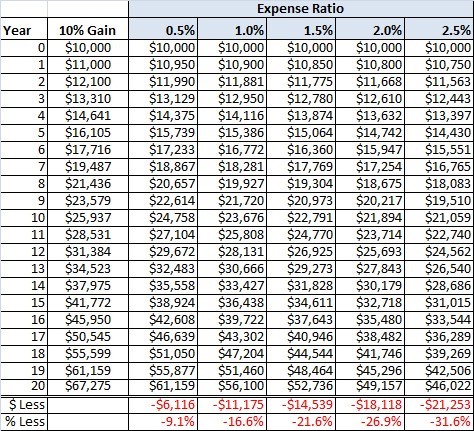
52 Week Range or stock price range for the previous 52 weeks the ETF has sold at per share, e.g., $165.96-$198.93 as of 7/20/2016. *Note: Prices change constantly and are never predictable.
Dividend Frequency is how often an ETF will provide you with dividends, e.g., Annually (1 time a year), Biannually (2 times a year), or Quarterly (4 times a year).
Ex-Dividend Date is the last amount paid to investors per share they own of any stock, ETF, or Bond, e.g., $0.95300 per share owned on 6/27/2016.
Category & Style are used to describe an ETFs market focus and asset size, e.g., U.S. Stock Market or Large Cap/Blend.
URL for more information will provide further details on a specific ETF or Bond, e.g., Vanguard S&P 500 ETF.
Okay, now that it’s clear what we’ll be looking at, how about we start reviewing these ETFs and Bonds. To make this easy on ourselves, let’s break this into a few sections so we can look at the various types of ETFs and Bonds, which will be varied by market exposure and pricing. Starting with, low-cost S&P index funds while keeping in mind these should comprise 90% of your investment portfolio. Then moving on to short-term government bonds comprising the remaining 10% of your portfolio.
LOW-COST S&P INDEX FUNDS – 90% OF PORTFOLIO LARGE MARKET CAPITALIZATION
These are ETFs which are comprised of companies whose total market capitalization or financial size is over $10 Billion dollars. They would include companies such as, Apple, Exxon-Mobile, Wal-Mart, Ford Motor Company, and so on. The benefit of owning these ETFs is that, you are purchasing a fraction of each company for a far less price then their individual stock prices.
Name: Vanguard S&P 500 ETF Ticker Symbol: VOO
Expense Ratio: 0.05%
52 Week Range: $165.96-$198.93 as of 7/20/2016
Dividend Frequency: Quarterly
Ex-Dividend Date: $0.95 per share on 6/27/2016
Category & Style: Large Cap/Blend (Mimic S&P 500 stocks)
URL for more information: Vanguard S&P 500 ETF
Name: Schwab U.S. Large-Cap ETF Ticker Symbol: SCHX
Expense Ratio: 0.03%
52 Week Range: $41.50-$51.53 as of 7/20/2016
Dividend Frequency: Quarterly
Ex-Dividend Date: $0.24 per share on 6/20/2016
Category & Style: Large Cap/Blend (Mimic Dow Jones Large Cap)
URL for more information: Schwab U.S. Large-Cap ETF
Name: Vanguard Total Stock Market ETF Ticker Symbol: VTI
Expense Ratio: 0.05%
52 Week Range: $91.58-$110.99 as of 7/20/2016
Dividend Frequency: Quarterly
Ex-Dividend Date: $0.47 per share on 6/14/2016
Category & Style: Large Cap/Blend (Total market exposure)
URL for more information: Vanguard Total Stock Market ETF
Name: iShares Core S&P Total U.S. Stock Market ETF Ticker Symbol: ITOT
Expense Ratio: 0.03%
52 Week Range: $76.41-$98.75 as of 7/20/2016
Dividend Frequency: Quarterly
Ex-Dividend Date: $0.48 per share on 6/14/2016
Category & Style: Large Cap/Blend (Total market exposure)
URL for more information: iShares Core S&P Total U.S. Stock Market ETF
Name: Vanguard Value ETF Ticker Symbol: VTV
Expense Ratio: 0.08%
52 Week Range: $72.25-$87.79 as of 7/20/2016
Dividend Frequency: Quarterly
Ex-Dividend Date: $0.48 per share on 6/21/2016
Category & Style: Large Cap/Value (Mimic MSCI US Prime Market)
URL for more information: Vanguard Value ETF
MID MARKET CAPITALIZATION
These are ETFs which are comprised of companies whose total market capitalization or financial size is between $2 – $10 Billion dollars. They would include companies such as, Harley-Davidson, Mattel, Western Union, and so on. The benefit of owning these ETFs is that, you are purchasing a slightly larger fraction of each company for a far less price then their individual stock prices.
Name: Vanguard Mid-Cap ETF Ticker Symbol: VO
Expense Ratio: 0.08%
52 Week Range: $102.85-$129.94 as of 7/20/2016
Dividend Frequency: Quarterly
Ex-Dividend Date: $0.47 per share on 6/14/2016
Category & Style: Mid Cap/Blend (Mimic MSCI US Mid Cap 450 Stocks)
URL for more information: Vanguard Mid-Cap ETF
Name: Schwab U.S. Mid-Cap ETF Ticker Symbol: SCHM
Expense Ratio: 0.03%
52 Week Range: $28.44-$43.52 as of 7/20/2016
Dividend Frequency: Quarterly
Ex-Dividend Date: $0.10 per share on 6/20/2016
Category & Style: Mid Cap/Blend (Mimic Dow Jones Mid Cap Total Market)
URL for more information: Schwab U.S. Mid-Cap ETF
Name: iShares Core S&P Mid-Cap ETF Ticker Symbol: IJH
Expense Ratio: 0.12%
52 Week Range: $109.03-$154.93 as of 7/20/2016
Dividend Frequency: Quarterly
Ex-Dividend Date: $0.61 per share on 6/21/2016
Category & Style: Mid Cap/Blend (Mimic S&P 400 Mid Cap Total Stocks)
URL for more information: iShares Core S&P Mid-Cap ETF
SMALL MARKET CAPITALIZATION
These are ETFs which are comprised of companies whose total market capitalization or financial size is between $300 Million – $2 Billion dollars. They would include companies such as, Papa John’s International, Buckle Inc., Celestica Inc., and so on. The benefit of owning these ETFs is that, you are purchasing a larger fraction of each company for a far less price then their individual stock prices.
Name: Vanguard Small-Cap Index Fund Ticker Symbol: VB
Expense Ratio: 0.08%
52 Week Range: $90.03-$122.50 as of 7/20/2016
Dividend Frequency: Quarterly
Ex-Dividend Date: $0.30 per share on 6/14/2016
Category & Style: Small Cap/Blend (Mimic CRSP US Small Cap)
URL for more information: Vanguard Small-Cap Index ETF
Name: Schwab U.S. Small-Cap ETF Ticker Symbol: SCHA
Expense Ratio: 0.07%
52 Week Range: $43.79-$58.04 as of 7/20/2016
Dividend Frequency: Quarterly
Ex-Dividend Date: $0.14 per share on 6/20/2016
Category & Style: Small Cap/Blend (Mimic Dow Jones Small Cap Market)
URL for more information: Schwab U.S. Small-Cap ETF
Name: iShares Russell 2000 ETF Ticker Symbol: IWM
Expense Ratio: 0.2%
52 Week Range: $93.64-$125.68 as of 7/20/2016
Dividend Frequency: Quarterly
Ex-Dividend Date: $0.62 per share on 7/06/2016
Category & Style: Small Cap/Blend (Mimic Russell 2000 Index)
URL for more information: iShares Russell 2000 ETF
SHORT-TERM GOVERNMENT BONDS – 10% OF PORTFOLIO
These are Bonds which are comprised of short-term U.S. government savings bonds, Treasury bonds, or Treasury inflation protected securities which are typically one to five years in length. The benefit of owning these is that, every year you will earn interest and when the bond matures you will receive your original invest back.
Name: Vanguard Short-Term Government Bond ETF Ticker Symbol: VGSH
Expense Ratio: 0.10%
52 Week Range: $60.68-$68.51 as of 7/20/2016
Dividend Frequency: Monthly
Ex-Dividend Date: $0.05 per share on 7/01/2016
Category & Style: U.S. Treasury Bonds (Barclays U.S. 1-3 Year Float Adjusted)
URL for more information: Vanguard Short-Term Government Bond ETF
Name: iShares Core 1-5 Year USD Bond ETF Ticker Symbol: ISTB
Expense Ratio: 0.12%
52 Week Range: $98.99-$101.57 as of 7/20/2016
Dividend Frequency: Monthly
Ex-Dividend Date: $0.17 per share on 7/01/2016
Category & Style: U.S. Treasury Bonds (Mature in 1-5 years)
URL for more information: iShares Core 1-5 Year USD Bond ETF
Name: Schwab Short-Term U.S. Treasury ETF Ticker Symbol: SCHO
Expense Ratio: 0.08%
52 Week Range: $50.37-$51.73 as of 7/20/2016
Dividend Frequency: Monthly
Ex-Dividend Date: $0.04 per share on 7/01/2016
Category & Style: U.S. Treasury Securities (Barclays U.S. 1-3 Year Treasury Bond)
URL for more information: Schwab Short-Term U.S. Treasury ETF
Name: iShares Core 1-3 Year Treasury Bond ETF Ticker Symbol: SHY
Expense Ratio: 0.15%
52 Week Range: $84.31-$85.35 as of 7/20/2016
Dividend Frequency: Monthly
Ex-Dividend Date: $0.05 per share on 7/01/2016
Category & Style: U.S. Treasury Bonds (Mature in 1-3 years)
URL for more information: iShares Core 1-3 Year Treasury Bond ETF
UNDERSTANDING WHERE TO START
Seeing the look in John’s eyes, I could tell he was a bit overwhelmed with all the information, but that he was also thinking a lot about which funds to purchase to provide him the highest levels of returns. I said to John that I know there are a lot of choices for you to choose from but to keep it simple when he first starts out. If you remember from before, Warren Buffett said to purchase 90% in low-cost S&P Index Funds but this can have different meanings for different investors.
Some investors perhaps have a bit more money to start with, so they can afford to purchase a few different ETFs from each level of market capitalization. For those investors with fewer funds like John it may be good to start with just purchasing one or two types of ETFs. Warren has even stated, that his suggestion is to purchase Vanguard’s ETFs because of their lower costs and good rates of returns. So, that might be a good help to those who are unsure what to start with. As always, do your homework! That means, spend a few minutes to learn about those ETFs you want to invest in and at least make sure you understand why you are investing in them.
This advice holds true for the short-term U.S. government bonds as well. Just purchasing them because a famous investor says so should never be enough. Make sure you understand why you are purchasing it, and that you could easily explain why its good for you to anyone. This will make it easier to have greater confidence in your purchases and not cost you too much time to learn about.
UNDERSTANDING THE WHY
Why would Warren Buffett, a highly successful investor himself, suggest this investment strategy for almost everyone to follow? Just so we’re clear, he doesn’t just say this as a general statement, he actually believes in this strategy so much he has set up a trust to follow this exact investment strategy for his wife after he passes away.
Not only that, but Warren believes so strongly in this investment strategy he has made the largest wager in investment history to prove his point. See, there are many financial groups and fund managers who disagree with Warren on the simplicity and effectiveness of this strategy. So, he decided the best way to prove his point was to bet a handful of hedge funds $1Million dollars that they could not outperform a low-cost Index Fund over a ten-year period. The winner will get to donate their winnings to the charity of their choice.
The bet started in 2008, with Warren choosing only one Index Fund, the Vanguard 500 Index Admiral Shares (VFIAX). His opponent is Protégé Partners, a money management firm in New York City and they choose five hedge funds. As of 2016, Warren Buffett’s single Index Fund is in a huge lead, earning him 65.7% in returns compared to his opponents who have only earned 21.9% with their five hedge funds.
This is a fantastic example of how profitable Index Funds/ETFs are, and how good an investor Warren Buffett is. I will always encourage you to do your homework and research what you want to invest in before you do so, but if you were to take any advice on how to invest, then it seems like Warren’s is really good. Here are some of the benefits of this investment strategy which is a lot more successful then any other strategy available to most investors.
- By buying and holding ETFs and Bonds for many years and reinvesting dividends, your investments will increase in size due to the power of compounded interest.
- This method of passive investing in low-cost index funds, keeps fees as low as possible which maximizes your returns.
- You are maximizing tax efficiency by buying and holding for decades instead of days which can cost you a great deal in taxes.
- The strategy is easy to implement and very straight-forward making it a simple method to follow.
- You can sleep well knowing that you are following the greatest investor of all-times advice, Warren Buffett, and that it’s free advice! Article Title: How to Build a Warren Buffett Portfolio, Author: Blain Reinkensmeyer.
It’s easy to see why Warren is considered the greatest investor of all time and that he really does follow his own investment strategy advice. It’s good to note that I didn’t mention the Vanguard 500 (VFIAX) ETF fund as a potential fund to invest in since the minimum balance required is $10,000. However, Vanguard’s 500 S&P ETF (VOO) delivers the same results but with no minimum balance. Several of the larger financial reporting services agree with this strategy and it’s been reported by both Bloomberg and Investopedia, that by following Warren Buffett’s advice investing in low-cost Index and Bond Funds, any investor can do well. They have each recommend investing in Vanguard’s 500 S&P ETF (VOO) and iShares Core 1-3 Year Treasury Bond ETF (SHY).
RETURNS FROM INVESTING IN S&P 500 ETF
By this point I could see that John was getting more excited about the world of investing after hearing how easy it is to invest in good companies. That is when I informed him of the magic of compounding. Alright John, now that we’ve looked over several ETFs and Bonds we can start investing in right away, let’s focus on what to do with our earnings. You mean we don’t just spend the money we’ve earned from our dividends? replied John.
Yes, of course we can spend what we’ve earned from our dividends but then we would be missing out on the most magical gift of all. What’s that? John said. The magic of compounding. Compounding is truly amazing since it will help us increase our earnings by leaps and bounds. It was Albert Einstein who once said, “Compounded interest is the eighth wonder of the world. He who understands it, earns it… he who doesn’t… pays it.”
“The wonder of compounding (sometimes called “compound interest”) transforms your working money into a state-of-the-art, highly powerful income-generating tool. Compounding is the process of generating earnings on an asset’s reinvested earnings. To work, it requires two things: the re-investment of earnings and time. The more time you give your investments, the more you are able to accelerate the income potential of your original investment, which takes the pressure off of you.
To demonstrate how it works, let’s look at some examples. If you invest $1,000 today at 6%, you will have $1,060 in one year ($1,000 x 1.06). Now let’s say that rather than withdraw the $60 gained from interest, you keep it in there for another year. If you continue to earn the same rate of 6%, your investment will grow to $1,123.60 ($1,060 x 1.06) by the end of the second year. Because you reinvested that $60, it works together with the original investment, earning you $63.60, which is $3.60 more than the previous year.
This little bit extra may seem like peanuts now, but let’s not forget that you didn’t have to lift a finger to earn that $3.60. More importantly, this $3.60 also has the capacity to earn interest. After the next year, your investment will be worth $1,191.02 ($1,123.60 x 1.06). This time you earned $67.42, which is $7.42 more interest than the first year. This increase in the amount made each year is compounding in action: interest earning interest on interest and so on. This will continue as long as you keep reinvesting and earning interest.” Article Title: Investing 101: The Concept Of Compounding, By Investopedia Staff.
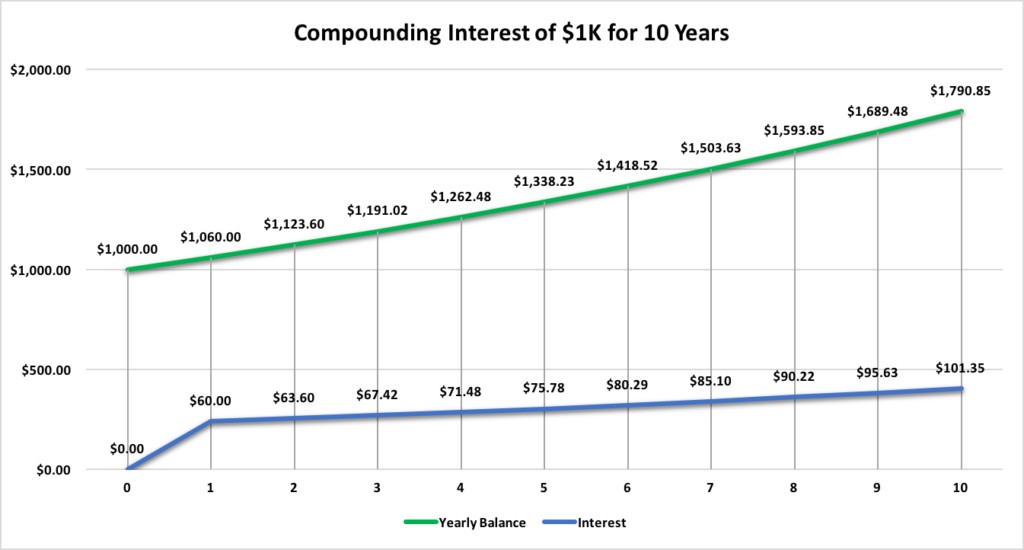
To illustrate this point further, let’s say there are two individuals, Heidi and Brad who started investing in 1965. Here is what their earnings would look like today when we apply this concept of compounding interest. Both Heidi and Brad are the same age, but when Heidi was 25 she invested $5,000 at an interest rate of 5.5%. To keep things simple, we’ll assume the interest rate was compounded annually. By the time Heidi reaches 50, her investment will be worth $19,066.96! Heidi’s friend, Brad, did not start investing until he reached age 35, and at the time he invested $5,000 with the same interest rate of 5.5% compounded annually.
By the time Brad reaches 50, his investment will be worth $11,162.38. So, what happened? Why the huge difference in total earnings? Both Heidi and Brad are 50 years old, but Heidi has $7,904.58 more in her savings account than Brad, even though his investment principle is the same amount of money as hers! By giving her investment more time to grow, Heidi earned a total of $14,066.95 in interest over the course of 25 years while Brad only earned $5,580.47 over the course of 15 years. Article Title: Investing 101: The Concept Of Compounding, By Investopedia Staff
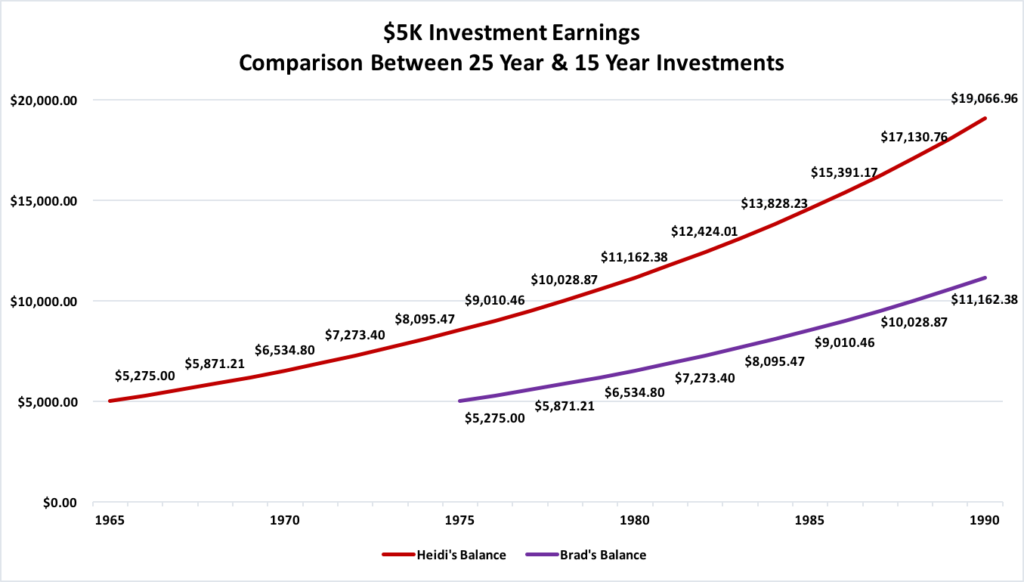
COMPOUNDING INTEREST FROM S&P 500
Investing in the stock market can actually generate these kind of returns for you because of the power of compounding interest. That is why it’s often referred to as the greatest wealth building tool the world has ever seen. To see how this works let’s say that you make about $50,000 per year and you’ve decided to contribute 10% or $417 per month to your 401k. Your company also has a retirement match program up to $5,000, which means they will match your contribution up to $5,000.
That means your total annual contribution will be $10,000. You decide to put all of your money into a low cost S&P 500 Index Fund, since the average return for the S&P 500 has been 10.5% going all the way back to 1975. For this scenario, you will invest $10,000 per year and you will receive the S&P 500 annual return of 10.5% (compound interest of 10.5% + $10,000 per year).
- After 5 years you will have $61,662
- After 10 years you will have $163,246
- After 15 years you will have $330,600
- After 20 years you will have $606,308
- After 25 years you will have $1,060,552
- After 30 years you will have $1,808,815
This means you will actually be a millionaire within your lifetime, can you believe that. What if you reinvest all the dividends you earned and manage to get your average annual return up to 12%? After 30 years, you will have $2,413,327. That’s not too bad if you ask me. The sooner you can start investing the better but if you haven’t started investing, what are you waiting for? Article Title: Compound Interest: A Key Investment Principle, Author: Marios Alexandrou

FUTURE RETURNS FROM INVESTING IN ETFS
I’m sure it’s great to learn how compounding interest works in hypothetical examples, but how would it work in real life is probably what you’re asking yourself. Yes, it’s great to see the returns on an investment of $10,000 if you have that kind of money available but the reality is you probably have much less to invest. Well, how about we look at another example but this time we use real world factors. Okay, so let’s say you only have $100 to invest initially in the S&P 500 index and that with a little budgeting you can continue to invest $100 per month for every month. Does that sound like a more reasonable and real-world scenario, I asked John. He replied that this was actually his current financial situation and this example would be very helpful for him.
For our example then, we will take $100 as your initial investment or principle and put that money into an S&P 500 Index. Now, you will also contribute $100 every month without fail, into this investment, so each year your total investment will increase by $1,200. Let’s say you started investing your money into the S&P 500 Index in 1965 with an average rate of return of 9.485%. By the beginning of the year 2016 what would your total investment be worth?
Starting Year: 1965 January
Ending Year: 2016 January
Initial investment: $100 totaling $1,200 per year
Investment time period: 51 years
Average rate of return (interest + dividend reinvestment): 9.485%
1 Year
Year: 1965 Total Investment: $1,200
Interest Earned: $60.80 Total Earnings for Year: $1,260.80
10 Years
Year: 1974 Total Investment: $12,000
Interest Earned: $1,649.94 Total Earnings for Year: $19,604.33
20 Years
Year: 1984 Total Investment: $24,000
Interest Earned: $5,853.17 Total Earnings for Year: $68,121.80
30 Years
Year: 1994 Total Investment: $36,000
Interest Earned: $16,255.41 Total Earnings for Year: $188,194.53
40 Years
Year: 2004 Total Investment: $48,000
Interest Earned: $41,999.26 Total Earnings for Year: $485,354.72
51 Years
Year: 2015 Total Investment: $61,200
Interest Earned: $115,851.51 Total Earnings for Year: $1,337,828.64
Article Title: S&P 500 Index, Author: Wikipedia contributors
WOW! Literally, after investing in the S&P 500 Index Fund for the past 51 years with only $1,200 yearly, your investment would now be worth $1.3 Million dollars! John’s eyes widened to a size I’d never seen before and he looked astonished at the total amount written on the paper before him. That is the power of compounding interest my friend. You would have earned over $1.28 Million in interest alone. This chart gives us a quick peak at what your 50 years’ investment would have looked like.
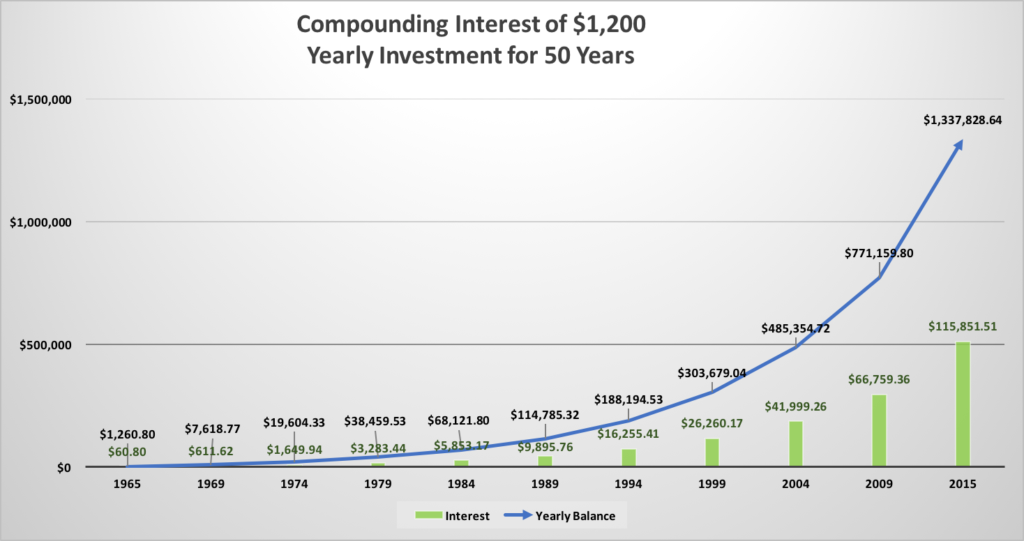
After seeing all of these numbers John’s eyes grew huge and he looked at me and said, But, if the returns are so good then why wouldn’t everyone be investing in the market? This is another great question I replied, but the problem is, investing for many people is seen as gambling. They think it’s a huge risk they are taking, and unless they can invest in something to make money quickly, then they they fear they will loose their investment. The problem most people have is that they don’t look at investing as a long-term business, but rather see it as a short-term game. If you are serious about becoming wealthy, then investing in the stock market has to be treated like a business.
Having said that, it’s good to note that the S&P 500 has not always had great years and their returns have been sometimes not good. For example, between 1973 and 1974 the S&P annual return was negative ranging from -14.66% to -26.47%. While during 2000 – 2002 the annual return ranged from -9.10% to -22.10% and in 2008, the S&P had its lowest return of -37.00%. Now, I know this sounds terrible and cause for most people to want to pull their money out of the stock market during any of these times but it’s also important to note that the years both preceding and following these downturns were growth years. Years in which the market grew and your rate of return varied between 1.38% to 37.58% with an average around 15.79%.
Meaning, overall your investment would still do very well and continue to grow even with a few years of minimal or zero growth. This simple little fact is why most people don’t invest in the market. They are afraid that the bad years outweigh the good ones and only focus on those. Instead they should be focusing on the long-term for their investment and how it will return huge rewards. A quote by the famous investor, Peter Lynch summarizes this point very well. “You get recessions, you have stock market declines. If you don’t understand that’s going to happen, then you’re not ready, you won’t do well in the markets.”
While we are on the subject of returns why don’t we do a projection forward to see what would happen. For example, let’s look at what would happen if you invested in the S&P 500 index today and what your return would be in 10 years from now. We’ll keep everything the same as before except we’ll adjust the rate of return to 7.76% to account for possible downward and upward trends over the next 10 years.
Starting Year: 2016 January
Ending Year: 2026 January
Initial investment: $100 totaling $1,200 per year
Investment time period: 10 years
Average rate of return (interest + dividend reinvestment): 7.76%
1 Year
Year: 2016 Total Investment: $1,200
Interest Earned: $49.87 Total Earnings for Year: $1,249.87
10 Years
Year: 2026 Total Investment: $12,000
Interest Earned: $1,248.95 Total Earnings for Year: $17,901.18
This is great right? With your initial investment of $100 and $100 added every month for a total of $1,200 per year, your earnings would be worth $17,901.18. Can you believe that? This means you will have gained over $5,900 in interest alone and it will only continue to increase. Image if you kept this money invested and kept going for the next 20, 30, 40, or 50+ years. Here’s what your earnings would look like.
20 Years
Year: 2035 Total Investment: $24,000
Interest Earned: $3,970.76 Total Earnings for Year: $55,698.18
30 Years
Year: 2045 Total Investment: $36,000
Interest Earned: $9,717.73 Total Earnings for Year: $135,503.75
40 Years
Year: 2055 Total Investment: $48,000
Interest Earned: $21,851.98 Total Earnings for Year: $304,007.30
51 Years
Year: 2066 Total Investment: $61,200
Interest Earned: $51,249.58 Total Earnings for Year: $712,239.61
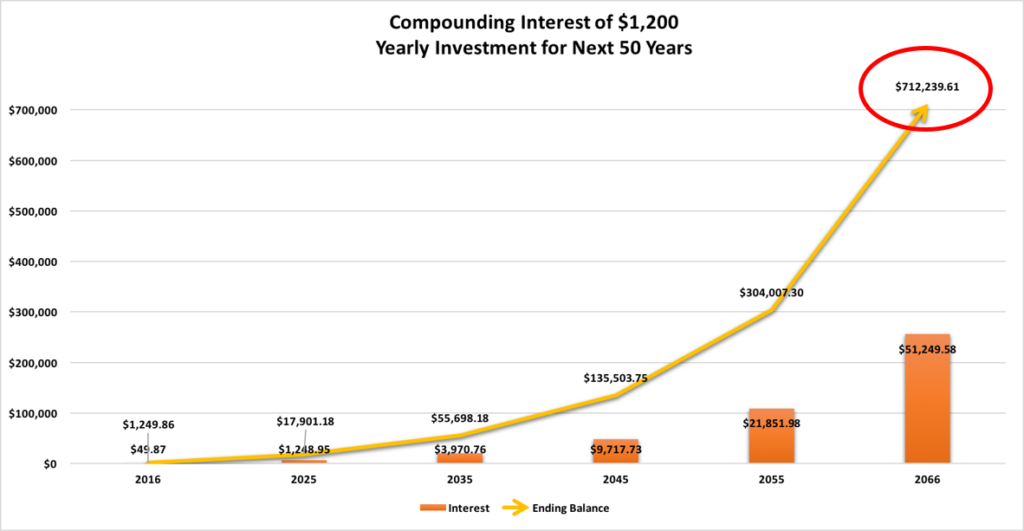
This means that for the next 50 years starting from today, you would increase your original investment of $1,200 for the first year into an investment worth $712,239! The interest earned would be over $51,000! This is why compounding is so important to understand, because it will continually increase your total earnings over time into huge sums.
Do me a favor John and think about what your life would be like if money was no longer an issue, I mean, seriously think for a moment, I said. Would you still be worried about how you and your wife will retire in the future or about taking care of your kids? Would you still be working non-stop or perhaps at some point realize you could start your own business? Would you always be so tired from working lots of hours per week and having less time with your family, or would you have more time to spend with them and feel energetic? And most importantly, would you be happy that your money is working for you to generate more wealth for your family versus you having to always work for it?
I don’t know about you, but I would rather have my money working for me, spending my time working on my own business, and seeing my family as much as possible. There’s nothing mystical about it really. The money you invest will continue to grow in accordance with the market index which is comprised of the top 500 performing companies in the U.S. As you earn interest on your annual investment you also gain dividends which can be reinvested helping you earn even more. That is the true power of compounding.
5) THE BEST WAY TO INVEST USING DOLLAR COST AVERAGING WHAT IS DOLLAR COST AVERAGING (DCA)
I think it’s becoming clearer how following Warren Buffett’s investing advice really pays off. With the power of compounding interest adding to your yearly investment, increasing it by huge sums will result in a nice amount over any given length of time. Really all you need is a small investment and time to allow it to grow to a sizable amount. Spending as little as $1,200 a year as we discovered, can really get you well on your way to being wealthy and comfortable in the future.
Our previous examples all relied on investing once a year with a lump sum of money but what if there was a better way to go about this? What if we applied a method of investing called Dollar Cost Averaging? What is that? John asked. Dollar cost averaging or DCA is an investment technique where an investor will buy a specific investment on a regular schedule, regardless of the share price. They will be able to purchase more shares when prices are lower, and fewer shares when prices are higher. It is also referred to as a constant dollar plan.
Eventually, the average cost per share of the ETF reduces becoming smaller and smaller, because the share price is changing constantly. Dollar cost averaging lessens the anxieties that arise from trying to time an investment decision, and from monitoring the share prices on a daily basis. DCA also helps investors to build the discipline of investing regularly and not, ‘put it off till next time when things are right.’ Think of it as a way to put your investing habits on auto-pilot making it easy and overtime more affordable for you.
DCA works by having an investor spend the same amount of money on a constant basis, putting it into the same fund over a consistent time period. For example, you decide to invest $1,000 on the first of each month into a low-cost ETF Index Fund. Assume that over a period of five months, the share price of the ETF Index Fund at the beginning of each month was as follows:
- Month 1: $20
- Month 2: $16
- Month 3: $12
- Month 4: $17
- Month 5: $23
On the first of each month, by investing $1,000, you are able to buy a number of shares equal to $1,000 divided by the share price. In this example, the number of shares purchased each month is equal to:
- Month 1 Shares = $1,000 / $20 = 50
- Month 2 Shares = $1,000 / $16 = 62
- Month 3 Shares = $1,000 / $12 = 83
- Month 4 Shares = $1,000 / $17 = 58
- Month 5 Shares = $1,000 / $23 = 43
Depending on the price, more shares were purchased during some months, and less shares were purchased during other months. Regardless of how many were purchased, the total number of shares you own is 296, with an average share price of $16.77 you paid. Considering the current price of the shares is $23, this means an investment of $5,000 has turned into $6,808. It also means that you were able to buy more shares overall since three out of the five months would have resulted in you purchasing less shares then what you own now.
If you had invested all $5,000 on one of these days instead of spreading your money across five months, your total profitability would be higher or lower than $6,808 depending on the month you choose to make your investment. Unfortunately, no one can time the market to purchase an ETF at it’s lowest price, so, DCA is a safe strategy to ensure an overall favorable average price per share. What this really provides you with, is an easy and effective strategy to routinely purchase shares of whichever ETF Fund you choose. Article Title: Dollar-Cost Averaging (DCA) Definition
THE COSTS OF PURCHASING ETFS
As we can see, Dollar Cost Averaging is really something which can prove useful to you when getting into the habit of purchasing index shares. It’s also good because it allows you to rest easier at night knowing that your money is on average buying you more shares. That’s one of its key benefits, well that, and realizing you’re actively adding to your wealth on a consistent basis over a period of time. Okay, so then how does DCA work when purchasing ETFs?
Well, we’ve already covered the fact that each time you make an investment into an ETF, the costs involved are minor compared to those if you were to have utilized a fund manager. Its also worth noting that since this cost is a percentage, it has no negative effects on the benefits of dollar cost averaging. Purchasing costs also known as trading fees, however, are a different story all together. These are fees which a brokerage firm will charge whenever you buy or sell anything on the stock market.
Trading fees can add up quickly if you’re buying or selling stocks on a daily or even weekly basis. This can have an impact on your investments when using dollar cost averaging with small dollar amounts. Making it not practical to purchase ETFs too often since the trading costs will reduce your investment’s performance. Even brokerage firms offering lower flat-rate trading fees of $10 can end up taking a chuck out of small periodic investments. Consider the impact of these purchase costs on the following investments:
- A $25 investment with a flat-rate trading fee of $10, becomes a $15 investment after the trading fees are subtracted. The percentage of your investment spent on this fee is 40%.
- A $50 investment with a flat-rate trading fee of $10, becomes a $40 investment. The percentage of your investment spent on this fee is 20%.
- A $100 investment with a flat-rate trading fee of $10, becomes a $90 investment. The percentage of your investment spent on this fee is 10%.
- A $1,000 investment with a flat-rate trading fee of $10, becomes a $990 investment. The percentage of your investment spent on this fee is 1%.
As you can see, the flat-rate trading fee remains the same regardless of how much you invest, and when you invest in slightly larger sums the impact of these fees go down. In order to successfully apply dollar cost averaging to the purchasing of ETFs will require investing either larger sums on a consistent basis, or on investing a set amount on a scheduled basis. ETFs can be excellent vehicles for dollar cost averaging, if the dollar cost averaging is done properly. Article Title: Dollar-Cost Averaging With ETFs, By Investopedia Staff.
HOW TO APPLY DOLLAR COST AVERAGING
So, it’s easy to see how Dollar Cost Averaging (DCA) works and why it can be of great use to us. By engaging in DCA it helps remove some of the pressure of investing for us. We know that every month we will be investing $100 into our ETF index fund regardless of the price. However, this can prove costly as we discussed before, due to the fees our broker will charge us in buying stocks every month. What then is our alternative?
We simply save the $100 every month that we will be investing into the market and set-up an investment plan which will happen every three, four, six, or twelve months at a time. This way, we can still invest in the market with either $300, $400, $600 or $1,200 at a time but our broker fees drop significantly. If you decided to make monthly investments of $100, you will then be paying a $10 broker fee every month. This means you’re only investing $90 a month or $1,080 a year resulting in 10% monthly fees.
However, if you decide to make an investment plan of every three, four, six, or twelve months then your broker percentage fee decreases. For example, investing every six months your broker fee still remains at $10 but the money you invest is now $590 with a fee of 1.7%. Depending on which investment plan you choose below, this is what your purchasing costs would look like:
- A three-month investment of $300 with a flat-rate trading fee of $10, becomes a $290 investment. Resulting in you spending 3.3% for this fee.
- A four-month investment of $400 with a flat-rate trading fee of $10, becomes a $390 investment. Resulting in you spending 2.5% for this fee.
- A six-month investment of $600 with a flat-rate trading fee of $10, becomes a $590 investment. Resulting in you spending 1.7% for this fee.
- A twelve-month investment of $1,200 with a flat-rate trading fee of $10, becomes a $1,190 investment. Resulting in you spending 1% for this fee.
To illustrate this point further let’s look at what the historical investment in the Vanguard S&P 500 ETF would have looked like, and then how a future 10-year investment would be handled using our $100 monthly investment strategy. In addition, we’ll compare between investing every six months versus yearly just so we can see how they differ. Please note two things. First, that the Vanguard S&P 500 VOO ETF was not started until the middle of 2010 so our data begins from that point forward. Second, the historical prices listed are actual historic prices of Vanguard’s ETF and were collected from YCharts.com.
Historical 6 Month Investment with Vanguard S&P 500 ETF, VOO
Starting Year: 2010 Current Year: 2016
Initial investment: $600 Monthly contribution: $100 totaling $1,200 per year
Investment Occurrence: Every 6 months or 2 times a year
1 Year
Year: 2010 Total Investment to Date: $600
Stock Price: $101.32 Total Shares Purchased for Year: 5
6 Year
Year: 2016 Total Investment: $7,800
Stock Price: $192.56 Total Shares Purchased for Year: 53
So, as you can see if you started purchasing the VOO ETF over the past 6 years you would own 53 shares of it now. This is because you would be buying however many shares your $600 will get you twice a year. Sometimes the market price would be lower allowing you to purchase more shares while other times it would be higher causing you to buy fewer shares. Additionally, you would use any remaining money from the previous investment interval to buy more shares in the next interval. Overall, you will have paid an average of $151.16 per share so it works out in your favor.
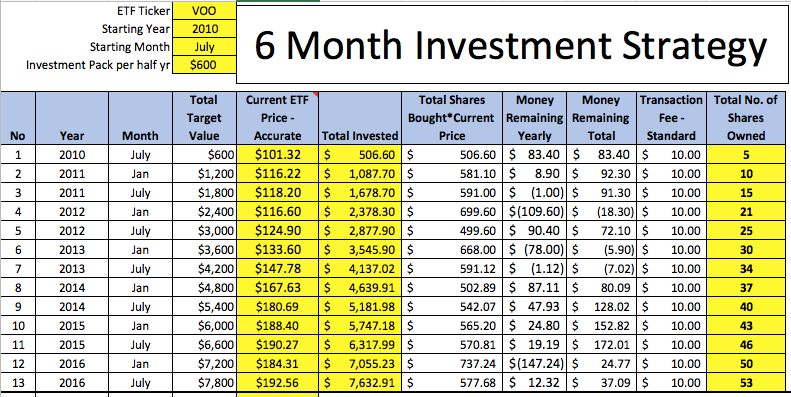
Future 6 Month Investment Projection with Vanguard S&P 500 ETF, VOO
Starting Year: 2016 Ending Year: 2026
Initial investment: $600 Monthly contribution: $100 totaling $1,200 per year
Investment Occurrence: Every 6 months or 2 times a year
1 Year
Year: 2016 Total Investment to Date: $1,200
Stock Price: $192.56 Total Shares Purchased for Year: 3
6 Year
Year: 2022 Total Investment: $7,800
Stock Price: $183.22 Total Shares Purchased for Year: 40
10 Year
Year: 2026 Total Investment: $12,600
Stock Price: $194.50 Total Shares Purchased for Year: 65
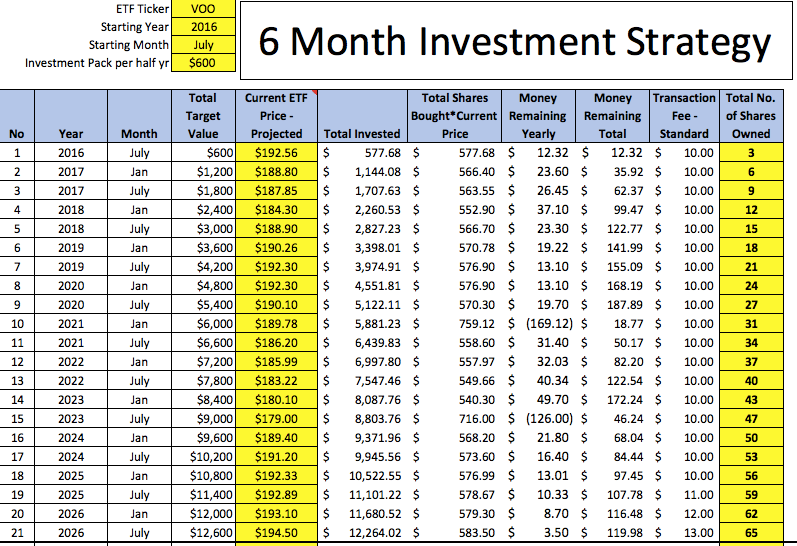
After 10 years of investing your $600 every 6 months you would own 65 shares. Your average stock price would be $188.81 making some years better to purchase more shares then others. Overall, your investment strategy will have paid off in the long run. Here’s how you would fair if you chose to invest once a year.
Historical 1 Year Investment with Vanguard S&P 500 ETF, VOO
Starting Year: 2010 Current Year: 2016
Initial investment: $1,200 Monthly contribution: $100 totaling $1,200 per year
Investment Occurrence: 1 time a year
1 Year
Year: 2010 Total Investment to Date: $1,200
Stock Price: $101.32 Total Shares Purchased for Year: 11
6 Year
Year: 2016 Total Investment: $8,400
Stock Price: $192.56 Total Shares Purchased for Year: 58
So, in this example you can see you would actually own a total of 58 shares by 2016. Overall, you will have paid an average of $151.19 per share which is close to the six-month investment strategy, so both work equally in your favor.
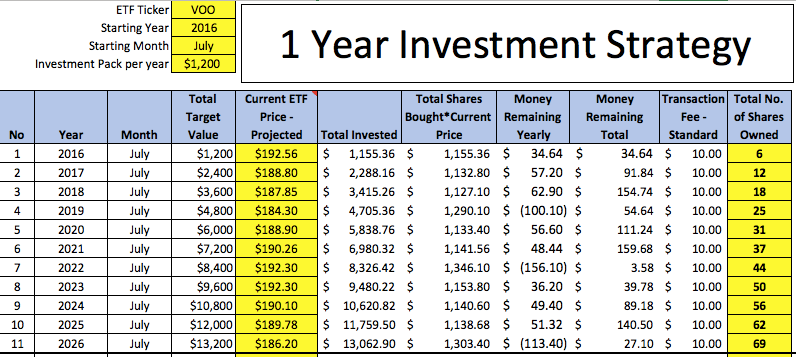
Future 1 Year Investment Projection with Vanguard S&P 500 ETF, VOO
Starting Year: 2016 Ending Year: 2026
Initial investment: $1,200 Monthly contribution: $100 totaling $1,200 per year
Investment Occurrence: 1 time a year
1 Year
Year: 2016 Total Investment to Date: $1,200
Stock Price: $192.56 Total Shares Purchased for Year: 6
6 Year
Year: 2022 Total Investment: $8,400
Stock Price: $192.30 Total Shares Purchased for Year: 44
10 Year
Year: 2026 Total Investment: $13,200
Stock Price: $186.20 Total Shares Purchased for Year: 69
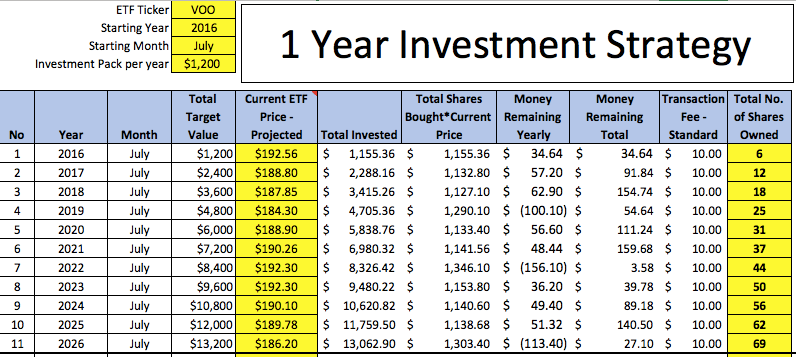
After 10 years of investing your $1,200 once every year you would own roughly 69 shares. Your average stock price would be $189.40 making some years better to purchase more shares then others. Overall, your investment strategy will have paid off in the long run. This is fantastic news as it means you can purchase more ETF shares depending on which investment plan you choose. One word of caution I have is to be careful in attempting to ‘time’ the market price. What I mean by ‘timing’ the market price, is don’t fall into the trap of believing you can predict the future price of your ETF, and wait for it to be at that magical number where you can buy the most amount of shares for your money.
No one, and I mean no one, not even all of the brokerage firms on Wall Street can do this. Sure, some months the price of the ETF might be lower then other months but from day-to-day, even minute-to-minute the price is always changing. Sometimes the price can jump really high in a matter of minutes while other times it can drop significantly overnight. My point is, choose which investment plan works best for you and stick to it. What ever month you choose to buy more shares just pick a day in which you’ll make your purchase and move on. This will help you stay focused on your investment goal, which is to have a financially healthy portfolio ready for whenever you may need it.
STI ETFs
Just to Add On, Of course In Singapore, we have our very own STI (Straits Times Index) which tracks the performance of 30 largest and strongest blue-chip companies listed on the Singapore Exchange (SGX).
The STI is an index, which is calculated from the performance of individual stocks. As such, you cannot “buy the STI”. For those who wish to gain exposure to the performance of the STI, they can buy into an Exchange Traded Fund (ETF) that seeks to replicate the performance of the STI.
There are currently two ETFs that track the performance of the STI:
SPDR Straits Times Index ETF (SGX: ES3)
Nikko AM Singapore STI ETF (SGX: G3B)
Singapore is one of the countries where ETFs are becoming increasingly popular as more people look for ways to gain exposure to the booming stock market. The fact that these investment vehicles are cost-efficient and less risky is seen as one of the reasons why income-focused investors are increasingly betting on them.
Reasons to Buy STI ETFs and have several advantages over a stock
- Allows easy diversifications – you can buy a basket of stocks and diversify yourself from spread the risks. STI ETFs ensure investors get exposure to not only the best-performing stocks but also the ones with minimal risks
- trading flexibility as ETFs can be bought and sold all day long
- transparency – the bid and ask prices can be seen at any time when the market is open.
- Mutual funds disclose their holdings on a quarterly basis, while ETFs disclose their portfolios every single day on public and free websites.
- have low management fees and operating expenses, thus letting investors keep more of their money to invest
- STI ETFs are tax efficient in that most of their tax on capital gains is paid on sale and completely up to the investor. Investors trading large volumes at times receive in-kind redemptions which allow them to redeem shares of the stocks that an ETF tracks, thus minimising tax implications.
What are the risks Involved?
- One of the risks involved in investing in ETFs is market risk. You are exposed to the volatility of the specific underlying assets or market(s) the ETF tracks. This risk cannot be diversified and during adverse market conditions the ETF’s value will decline accordingly.
- Another risk is tracking error, or the difference between the portfolio’s returns and the index it is meant to trace. This happens when the fund manager of the ETF is unable to perfectly replicate the performance of the index with the ETF tracks. The difference between the index and ETF returns are generally due to management fees, and timing differences.
- When an ETF is priced in a different currency from the local currency, you would also be exposed to foreign exchange risk. This can potentially increase or erode the ETF’s returns.
- As with most investment products, it is possible in certain situations that you can lose, or gain, a substantial amount of money.
ARE ETFS SUITABLE FOR EVERYONE?
Investing in ETFs may not be for everyone. They may not be suitable for you if you:
- Want potentially higher returns BUT are not prepared for variable returns which include the risk of losing all or a substantial part of your original investment amount;
- Do not understand how returns are determined or if you are unclear about the factors and scenarios that can affect returns;
- Do not understand the risks associated with the ETF. Investors should be aware of the risks associated with the use of derivatives by ETFs, including the risk that the provider or counterparty of the derivative defaults.
- Are not prepared to leave your money invested for long periods of time. A longer time horizon is generally preferred to ride out short term price fluctuations. But depending on the investor’s investment objective, some ETFs may be suitable for short term trading.
- Are not familiar with the ETF manager and the ETF’s track record.
KEY QUESTIONS TO ASK OR CONSIDERATIONS BEFORE BUYING AN ETF
ETFs differ in terms of complexity, investment objectives, strategies, risks and costs. When choosing an ETF, consider the following:
- i) Your needs and investment objectives, personal circumstances and risk profile.
ii) Find out more about the ETF you are considering:
- ensure that the ETF’s investment strategies are in line with your own investment objectives
- ensure that you understand all the risks (whether it is a cash-based or synthetic ETF) and are comfortable the ETF matches your risk profile
- ensure that you are comfortable that the fund manager has the necessary resources, experience and skills to manage your investment. Check that both the firm and the individuals managing the ETF have a credible performance track record. However, do note that past performance is not necessarily an indication of future performance.
iii) Find out about alternative investment products and compare their risk-return profiles and features with the ETF introduced to you.
HOW CAN I INVEST IN A STI ETF?
There are 3 main ways for Singaporeans to invest
1) STF ETF through a brokerage;
2) STF ETF through a monthly investment plan;
3) STF ETF with your CPF OA monies.
Method 1: Invest in A STI ETF Through A Brokerage
Since both the SPDR and Nikko AM ETFs are traded on SGX, you can simply invest by buying it through a stock brokerage the same way you would buy an individual stock.
Method 2: Invest in STI ETF Using Regular Shares Savings (Monthly Investment Plan)
Regular Shares Savings (RSS) plans, also known as monthly investment plans, is another good way to invest into a STI ETF over time, with starting capital of as little as $100 a month.
There are four financial institutions that offer RSS plans: Maybank Kim Eng Monthly Investment Plan, OCBC Blue Chip Investment Plan, Phillip Share Builders Plan and POSB Invest-Saver.
Benefits of this approach are simplicity (you set up a RSS plan online or at an ATM)
Method 3: Invest in STI ETF Using CPF Investment Scheme
You can also use your CPF Ordinary Account to invest in a STI ETF. It is one of the four approved ETFs that can be invested under the CPF Investment Scheme (CPFIS). To do so, you need to apply a CPFIS scheme account with one of the local banks and link it up with your brokerage account.
The process of buying the STI ETF using CPF monies is the same as you would do with cash, you just need to indicate on your brokerage platform that you are using CPF to pay for the shares. You can invest as much as you like after the first $20,000 in your CPF Ordinary Account.
HOW TO APPLY DOLLAR COST AVERAGING
So, it’s easy to see how Dollar Cost Averaging (DCA) works and why it can be of great use to us. By engaging in DCA it helps remove some of the pressure of investing for us. We know that every month we will be investing $100 into our ETF index fund regardless of the price.
A couple of years ago, POSB launched a saving plan called POSB Invest-Saver which allow anyone to invest in STI ETF using only a starting amount of $100. You just need to go to the nearest ATM machine, and you can set up in just a few minutes. Out of every $100 that you invest, 1% goes to the commission.
To know more details about this POSB Invest-Saver, click on their website >> https://www.posb.com.sg/personal/landing/invest–saver/index.html?pid=sg–posb–vanityinvestments–investsaver. You can also read their FAQ at >> https://www.posb.com.sg/personal/ibanking/faq/etf–rsp.page
Do note that this is not a recommendation, but it’s something for you to explore. What’s interesting is that once the plan is set up online, it will run on auto-pilot until you decide to terminate it. You can also increase/decrease the amount with multiples of $100 any time you want to.
CLICK TO VIEW STEPS TO SET UP THE POSB INVEST-SAVER
Okay, so now that we’ve seen what your investment would grown into over the next ten years, how about we get you started. How does that sound John? That sounds great! I’m really excited to start having my money work for me and to have compounding interest increase my overall investment size, John replied. That’s wonderful to hear John. Well, the first thing we need to do is get you an account with a brokerage firm. You do have the option to go to a local brokerage firm and open your account face-to-face with someone, but keep in mind they will charge you more fees for using their services.
These fees cover a wide range of things so if you do decide to go this route I would strongly suggest you have them go over every fee in length. Just because they may say an annual fee is 1% doesn’t mean it’s a small number. Remember what we discussed earlier about fund manager’s fees. Just make sure to be fully aware of what the costs involved would be before you register with their services. Also, I would recommend you ask them for references from their clients and speak with them about how they feel using this broker’s services. It’s always better to learn a little background before starting something you’re not entirely sure of.
To be honest with you John, I’d recommend signing up for an online brokerage firm which has no service fees and low transaction fees. There are several which come to mind, any of which will be good to use. Take a look at a few of the one’s I’ve listed below and choose whichever is best for you.
- TD Ameritrade – A trusted company with low fees and a secure, easy to use website. Known for its many trading options and vast resource library.
- Options House – Lower fees and a very easy to navigate website.
- Trade King – Also has low fees and easy to use website.
- Options Xpress – Minimum fees and owned by Charles Schwab, a reputable brokerage firm.
I think we’ll go ahead and use TD Ameritrade since it’s considered a very reputable online brokerage firm with no minimum balance required, a flat-rate transaction fee of $10, and no additional service fees. Also, you will have access to their vast investment library, tools, and additional web based platforms to help you with your investing. Let’s go through step-by-step how to register your account.
“To bring about this change in one’s life there must be passion. If one is to do anything worthwhile, one must have this intense passion” – J. Krishnamurti.
6) ACTION PLAN TO MAKE MONEY #1 – OPENING & FUNDING AN ACCOUNT
Click on this link to begin. TD Ameritrade Account Opening.
For tutorials, reference, or quick guides, stop: everything’s right here, in thinkorswim Learning Center. Take a look around!”
7) ACTION PLAN TO MAKE MONEY #2 – STEP BY STEP PROCESS PURCHASING AN ETF
So John, have you decided which ETF you will purchase for your first investment? After taking a look over the information you gave me earlier when we discussed the many Types of ETFs there are, I’ve decided to go with the Vanguard S&P 500, VOO ETF, he said. That’s great John, and I think you’ve made a good choice as it’s one of the ETFs I own as well. Alright, I’ll help guide you in the purchasing of your first ETF.
Click here for Steps how to purchase ETFs
INVESTMENT PLAN FOR 3, 4, 6, OR 12 MONTHS
Buying ETFs, Bonds, and Stocks is very easy as you just learned from our example above. Now, what we want to do is make sure you are following your investment plan which we discussed earlier. Once you have decided on your investment plan of 3, 4, 6, or 12 months the next thing to do is begin following it and make note of when your next investment month is.
For example, say you decided to follow the 6-month investment plan, this means you’ll be making purchases two times a year. If you made your first purchase in July, then you would be buying $600 worth of ETF shares. Let’s assume the average stock price in July is $196.39, you will be able to buy 3 shares for $589.17, plus the $10 transaction fee, for a total of $599.17. This will leave you with $0.83 to invest for next time. Here’s a quick recap illustrating your purchase:
- 6-month investment plan chosen. Investments will routinely be in July and January.
- $600 dollars invested every time with remainder of money to be used for the next investment period.
- July average stock price is $196.39.
- Buy 3 shares, totaling = $589.17.
- Add $10 transaction fee (brokerage standard fee for all transactions)
- Total purchase price for 3 shares = $599.17.
- $0.83 dollars remaining. Will be used to invest in January.
- Transaction Successful! You now own 3 shares of the VOO ETF!
Check your investment plan so you can prepare to purchase ETFs on a regular scheduled basis. Also, keep track of the money you have remaining so you can use it for the next investment period.
8) ACTION PLAN TO MAKE MONEY #3 – REGULAR PAYCHECK (DIVIDEND INCOME) DIVIDENDS REGULARLY PAYING YOU
Dividends are an amazing thing! This is due to the fact that when a company decides to pay its shareholders dividends you essentially are earning money by doing nothing. “A dividend is a cash payment from a company’s earnings; it is announced by a company’s board of directors and distributed among stockholders. In other words, dividends are an investor’s share of a company’s profits, given to him or her as a part-owner of the company. A steadily increasing dividend payout is viewed as a strong indication of a company’s continuing success.” Article Title: How Dividends Work For Investors, By Investopedia Staff
What this means for you, is that, you are receiving a regular paycheck in dividend income from your investments. That’s fantastic! Of course, this is great news but how do they work, how often do they occur, and what risks if any do they pose? These are all great questions and to make sure you understand fully what dividends do for you we’ll look at your investment as an example. With your purchase of the Vanguard S&P 500 ETF (VOO) you currently own 3 shares, totaling $589.17 dollars invested.
Dividends are simply a cash payment to shareholders from a company’s earnings over a set period of time. Usually, but not always, a company will earn a fair amount of money and decide to pay dividends to its investors rather then spend it on growth. This is often a good sign as it means a company’s financials are healthy, they are making money consistently, and its board of directors is choosing to share its wealth with their investors.
Often times, dividends are paid out on a quarterly basis since this times perfectly with each quarter in a fiscal year. If the company is dong well for the quarter, then they will pay dividends to their investors. Not all companies will follow this practice as some will pay biannually while others will pay annually. It depends on how the company is doing financially and if they are in the middle of expanding or growing.
Since your investment of the ETF, VOO is comprised of 500 different companies it will always pay you a dividend on a quarterly basis. The amount is taken from all of the companies paying dividends and then averaged, giving you a cash payout. Each dividend payment will be given to you for each share you own of the ETF. Over the course of 2015 – 2016, Vanguard’s VOO ETF has paid out cash dividends in the following amounts:
- Dividend amount: $0.95 per share – Paid on: June 21, 2016
- Dividend amount: $1.01 per share – Paid on: March 21, 2016
- Dividend amount: $1.09 per share – Paid on: December 21, 2016
- Dividend amount: $0.95 per share – Paid on: September 21, 2016
To see VOO’s dividend history check out Nasdaq.com for all of their quarterly payouts.
This means you will have earned $0.95 for each share you own of the VOO ETF for a total amount of $2.85! Now, I know this doesn’t sound like much but as you continue to purchase more shares this amount will increase and eventually result in a substantial amount. If you’re thinking to yourself, what are you going to do with $2.85, the possibilities of what you can do with this money are up to you, but it’s important to note that you do have a few options.
One option, is to reinvest your dividends to purchase more shares of an ETF. Although, it is a small amount you can still purchase fractions of shares by enrolling in a dividend reinvestment program (DRIP) which automatically takes your earned dividends and reinvests them for you. This may be good for you if you’re just starting out and want to increase the number of shares you own, which will result in you earning more in dividends every year.
It may be hard to see how this would benefit you in the short-term but image how much it will result in greater returns for you over the long-term. For example, let’s say an investor named, “Jane owns 2,000 shares of XYZ Corporation. Its stock trades at $25 per share and its annual dividend is $0.80 per share. Jane’s quarterly dividend would pay her $400. But if she enrolls in XYZ’s DRIP, that $400 would increase the shares she owns to 2,016.” Basically, you are having the magic of compounding interest work in your favor by reinvesting your dividends, like we discussed earlier. Article Title: Dividend Reinvestment Plan (DRIP)
However, there is another option and that would be to take the money you’ve earned and use it to supplement your income. You could use the $2.85 to make purchases, or keep the money in your account and let it build up to a sizable amount before withdrawing it. Image for a moment, how much you would have earned from your dividends over the past year depending on how many shares you owned:
- 3 shares owned would equal a $12 yearly return
- 30 shares owned would equal a $120 yearly return
- 100 shares owned would equal a $400 yearly return
- 300 shares owned would equal a $1,200 yearly return
So, you can see how over the course of one year you’ll have some incredible returns. Either reinvesting your dividends or withdrawing them have positive benefits depending on your goals and needs at that time. Make sure to weigh out what your needs are as they obviously change and make the best decision for yourself. I will say, it’s good to note that just like all income you earn dividends are no different in that they too are taxable. Don’t let that dissuade you from using your dividends but just be aware of this fact.
“The price of success is hard work, dedication to the job at hand, and the determination that whether win or lose, we have applied the best of ourselves to the task at hand” – Vince Lombardi.

Click here for view steps to Track Dividends in Your Account – Sign Up for Dividend Reinvestment Plan (DRIP) -How to Withdraw your Money
HELP WITH YOUR ACCOUNT
At various times using the TD Ameritrade platform you may have questions or need assistance in completing any of the steps we discussed above. When this happens, follow the steps below to get assistance either immediately or through email.
Step 1: At the top of your screen you will see ‘Contact Us’ and there are various options to seek assistance
Step 2: When you select ‘Chat Now’ a pop-up window appears on your screen. This is an automated online assistant which will help answer your questions. Simply, type in your issue or question in the filed at the bottom and then click ‘Send’ You will see a dialogue in which your issue or question is shown and several responses are given to try and resolve the matter.
10) STORY OF JOHN PART 2
After our meeting was finished John had successfully opened his online brokerage account, funded it, and purchased 2 shares of the Vanguard S&P 500 ETF, VOO. I have to admit it had been a while since seeing him, but his look had changed considerably from when he came in my office. When I greeted him, he looked tired but after we finished John looked relaxed and happy. Before he left I consulted him a bit further as he was unsure how to explain to his wife Natalie about his decision to invest in the stock market.
I informed John to go over all of the information he and I reviewed together and to be honest and open about everything. This way, Natalie would feel more comfortable with his decision and she could be more involved as it was something they could do together after all. Additionally, I gave John a few pieces of advice on how to look at his investing going forward.
THINGS TO KEEP IN MIND
The first thing to always keep in mind, is that investing is a business. You are not gambling or playing with your money, rather, you are buying businesses which will pay you based on their performances. So, whenever you are looking at purchasing another business, i.e. ETF, Bond, or Stock, make sure you know what you are buying and why you are buying it. I would recommend checking the following websites to gather information on future purchases before making them:
- Morningstar – Company information, market data, and historical information. This is a very good website and really easy to navigate.
- Yahoo Finance – News, market data, basic company information. A good website to check for news on companies.
- Google Finance – News, stock quotes, Stock, ETF, and Bond descriptions. A straight forward and easy to use site for basic stock information and tracking.
Also, look into company or ETF specific sites such as:
- Vanguard – Offering some of the lowest fees and profitable ETFs and Bonds. Considered to be an excellent investment choice by Warren Buffett.
- Charles Schwab – Low cost ETFs and Bonds with good returns. Another good choice for investing in ETFs.
- iShares – Competitive ETFs and Bonds with low fees. An alternative choice if either Vanguard or Charles Schwab ETFs are not for you.
The second thing you’ll want to do, is have an investment plan so that you know how much you will be investing and how often. Regardless if you are investing $100 every month for 12 months or $10,000 per year, make sure to follow your plan. Since you’re probably just starting out, I would suggest creating an investment plan for every 3, 4, 6, or 12 months so that, you keep your transaction fees down and stay on schedule. By having a simple and easy to adhere to plan, you ensure that you continue to build your investment portfolio and reap the rewards from staying disciplined enough to follow it. Read up on why it’s important to have an investment plan at:
- Investopedia – Gives lots of information on following an investment plan in small and easy to digest pieces.
- ETF Database – Has the basic information on ETFs and how to invest for anyone.
Third, set up a few accounts to handle your monthly income and earnings once your investments begin to repay you. What I mean by this, is to come up with a few creative ways to spend or reinvest money you’ve earned from your investments. One such method as described by T. Harv Eker is to create six accounts with each one doing something for you. Here is an example of what they would look like:
- 10-30% into your Financial Freedom Account for Investing
- 10-20% into your Financial Freedom Jar for Play and Rejuvenation
- 10-20% into your Long-Term Savings for Future Spending Account
- 10-20% into your Continuing Education Account
- 40-50% into your Basic Necessities Account
- 10-20% into your Giving & Donations Account
By creating these or other similar accounts you make sure to not only reinvest your earnings but to more importantly reward yourself. This is crucial to maintaining a long-term investment strategy as it allows you to enjoy yourself every so often. Rewarding yourself can be in any form, be it; taking your family out to the movies, going on a one-week holiday, paying off your loans or mortgage completely, even starting your own business.
Really, its about keeping yourself motivated and happy with your decision to invest in the stock market. By managing your money effectively, you gain more wealth and the freedom to do what you wish with that wealth. Mr. Eker said it best, ‘It comes down to this: either you control money, or it will control you. To control money, you must manage it. Money is a big part of your life, and when you learn how to get your finances under control, all areas of your life will soar.’ Eker, T. Harv. Secrets of the Millionaire Mind: Mastering the Inner Game of Wealth (pp.153-161). PerfectBound. February 2005.
Fourth, reassess your investment plan at least once a year either with your partner or with a financial advisor. As time progresses, things change and so to will your needs, and investment strategy. It’s always good to have at least one other person who can act as a sounding board when it comes to investing. Regardless, if it’s your partner or a financial advisor, make sure everyone has a clear understanding of your investment goals. Financial advisors can be useful in that, they will inform you how to increase your portfolio size or protect it in the event it’s incorrectly weighted, i.e. adding bond investments, or managing risks.
“Never regard your study as a duty, but as the enviable opportunity to learn to know the liberating influence of beauty in the realm of the spirit for your own personal job and to the profit of the community to which your later work belongs” – Albert Einstein.

MEETING FOR COFFEE
I’m very excited today, as my good friend John, his wife Natalie, and I will meet for coffee. John and I have been meeting on a regular basis to review his investments and share stories since he started investing in the stock market. For the first 18 months, John decided to use his monthly allowance of $100 and follow a 4-month investment plan. He was able to invest $390 ($400 – $10 transaction fee) each time and purchase a few shares of VOO.
John and Natalie decided to adjust their investment plan after seeing the returns they were earning from their ETFs. They increased their monthly contribution to $150, making their 4-month investment total amount $590 ($600 -$10 transaction fee). Not only that, but John and Natalie took my advice and approached their investing in the stock market as if it’s an actual business venture. John started off by meeting with me once a month for coffee and to discuss different ETFs, while Natalie started doing research to learn more about investing in the stock market.
Doing their homework, John and Natalie spent their time learning the difference between a speculator and value investor. Speculative investing is when an investor decides to make a high-risk trade because they are seeking to make a high return. While value investing is when an investor decides to make a lower-risk investment based on analysis of the company’s finances. Really, it’s the difference between making choices based on feelings vs research and analysis.
Then, they researched the differences between conservative, moderate, and aggressive investors. Depending on the level of risk tolerance an investor has will determine their investment strategy and style. Conservative investors look to earn income from low risk investments, while moderate investors are willing to take on a little more risk to earn a bit more income, and aggressive investors are willing to risk a lot to gain a lot. It comes down to, how much patience do you have when investing your money?
Some people want to make lots of money overnight so they will be more aggressive with their investments while others are willing to be patient and give their investments time to earn them money. This led them to the understanding that there are different investment strategies and some of these strategies are better suited to their needs like index investing vs. actively trading stocks similar to a day trader. Knowing this, gave them the desire to asses their investment goals for the next five, ten, twenty, and thirty years out. Although, they are comfortable with following Warren Buffett’s advice they know that in the future they may need to adjust their portfolio to accommodate their age and lifestyle.
John and Natalie learned about the four different types of assets or investments they can own. With the understanding, that the more assets you own the more income you are generating for yourself everyday. Their goal is to have several different streams of income coming from various assets/investments, such as:
Ownership investments (assets which increase in value over time)
- Stocks: Owning shares in a company.
- Businesses: Becoming self-employed entrepreneurs.
- Real Estate: Properties used for renting or selling.
- Precious objects: Gold, artwork, or collectibles sold for a profit.
Lending investments (assets you own and receive repayment on)
- Savings accounts: Bank lending money using your savings, repaying you with low interest rates.
- Bonds: Money you loan to corporations or governments and they pay you back a fixed interest rate plus your original loan.
- CDs (Certificate of deposit): A promissory note issued by a bank in exchange for your money and paid back to you with higher interest rates.
- TIPS (Treasury-inflation protected securities): US Treasury bonds which mature over time giving your original investment and interest back.
Cash equivalents (assets considered as good as cash)
- Savings accounts: Cash used when needed.
- Money Market Fund: Easy to liquidate investments with no fees and possible tax breaks.
Alternatives (assets which do not fall into the previous groups)
- Index Funds: The S&P 500 index fund comprised of the top 500 companies in the stock market today.
- Exchange Traded Funds (ETFs): Track index funds and mirror their fluctuating rates but traded like stocks.
- Mutual Funds: Investments comprised of a balance between stocks, bonds, cash, etc.
- Hedge Funds: High risk, more aggressively managed mutual funds which are not regulated by the U.S. Security and Exchange Commission (SEC).
- Options: Contract agreements between buyer and seller to buy/sell a specific stock on a set date for a set price.
- Futures or Commodities: Contracts between buyer and seller to buy/sell commodities like oil at a predetermined future date and price.
- Forex (FX): Buying and selling of different currencies to make a profit.
- Real Estate Investment Trusts (REITS): Real estate funds similar to mutual funds except they are traded like stocks.
- Precious Metals: Metals such as gold that is bought/sold but not traded like stocks.
- Venture Capital: Startups or small businesses investments.
They also took to growing their investment knowledge by; reading investment books, checking various financial websites, even attending seminars to improve their understandings. Some of the more notable ones to start with are:
Books
- Learn To Earn (1995) by Peter Lynch – A great introductory book on business, stock investing, and how they work together.
- One Up On Wall Street (1989) by Peter Lynch – A thorough book on what to look for when picking an individual company to invest in, and what all the investment numbers actually mean.
- The Seven Habits of Highly Effective People (1989) by Stephen Covey – A fantastic book on understanding and utilizing the seven habits of highly effective people.
- Rich Dad Poor Dad (1997) by Robert T. Kiyosaki – This book is all about the lessons taught to kids about money. The poor make money by working for it, while the rich make money by having their assets work for them.
- MONEY Master the Game: 7 Simple Steps to Financial Freedom (2014) by Tony Robbins – An easy to read and simply laid out book to help investors in their financial journey.
Websites
- Investopedia – Introduction to investing definitions, basic how to guides, stock simulator, and many other useful resources.
- StockTrader – How to build a portfolio similar to Warren Buffett’s.
- Investing Basics – YouTube videos on investing and ETFs.
- The Motley Fool – Understand the basics of investing.
- Yahoo Finance: Offers definitions and general overviews regarding investing.
Budgeting
- HarvEker – T. Harv Eker’s info on how to set up a budgeting system.
- LifeBudget – Mobile application useful in setting up your own personal budgeting system.
It now being the fifth year since John and Natalie started their journey into investing in the stock market, they have seen their financial gains increase significantly. By working together, they manage their investments and are now able to invest in a few different ETFs and Bonds to generate positive returns. Additionally, they are spending a few hours per week to learn more about their investments and how to maximize their investing strategy. Realizing, the more they know about themselves and the stock market, results in them making better choices.
They’ve also created a budget for themselves; to better manage their debt, live below their means, set aside some money for future investments, and take time to enjoy their lives more often. For the first time in several years, John and Natalie took some of their yearly returns and went on a small family vacation. John even went so far as to talk with his employer and get an assistant to help manage some of his workload, freeing up his time. When I speak or meet with John now, it’s like seeing a whole new person. Hence, the reason why I’m so excited to meet with the both of them, because they are always so full of energy and enjoyable to be around.
Whenever I used to speak with John, he was usually exhausted and often complained of not being able to afford things, but now, he is always excited and ready to discuss investment strategies. Both he and his wife, spend more quality time together with their family and neither one of them ever seems tired. See, for the two of them, they began to realize the freedom which comes with investing. Once you start seeing the returns on your investments and then begin to see compounded returns, everything changes. That is because, you are no longer working for your money, rather your money is now working for you.
Sure, they still both work their full-time jobs, but by being more creative with their schedules, reevaluating their lifestyle, and making adjusts which liberated some of their finances they are now able to actually have time to enjoy themselves. They take time to see their kids play sports, perform in the arts, or go to the park for fun. Each time they receive their monthly pay checks instead of immediately spending the money on their bills, they first put aside money for their investments, a little for themselves, and then take care of everything else. This small adjustment has resulted in them changing the way they look at the world and how they interact with it.
By creating and sticking to their newly designed budget, John and Natalie are actually able to save for their future retirement, put aside money for their kids needs, and enjoy themselves. One time I asked John, how did they manage to start saving so much money? Did they get pay raises, different jobs, sell their house? His reply, was that, they stopped buying things which they thought were of value like the newest television set, fanciest car, or hottest mobile phone. Instead, they took that same amount of money and bought things of actual value like ETFs, Bonds, Mutual Funds, and so on. They realized that by purchasing things which paid them back actually were much better investments for the long-term.
Both he and his wife realized the truly important things to them were their family and time together, so they made sure their budget and investment plans always focused on these areas first. Whenever they make a decision to buy something, they ask themselves will this investment give us back money, and more importantly will it give us more time to spend with our family. If the answer is yes, then they proceed to buy it but if the answer is no, then they simply walk away and move on. John said this simple approach changed everything for them. They are now so much happier and relaxed that it makes everything they do together enjoyable. John and Natalie stay focused on what’s important to them and that in return gives them exactly what they want. Happiness, Time, Money, and Security.
“If you can dream it, you can do it. Always remember that this whole thing was started with a dream and a mouse. All our dreams can come true, if we have the courage to pursue them” – Walt Disney.



